#Graphic Environment Operating System
Explore tagged Tumblr posts
Text

Doing more with less with GEOS by Jonathan Sturges, Alex Jacocks
GEOS/GeoWorks on C64, C128, Apple II and IBM XT clone
VCF East XIX
#vcfexix#vcf east xix#vintage computer festival east xix#commodorez goes to vcfexix#geos#Graphic Environment Operating System
27 notes
·
View notes
Text
Sasha here!
CW here for references to hypnosis;
With the recent vibe of robot girls being The Thing on here lately I thought it might be fun to share a related thing of mine that's been an ongoing project for a while. While I have not had the drive or capacity to really work on new updates for it for a long while (I just kinda came out of a bit of a dormancy which does not help), this project was the collision between my enjoyment of machine/robot/pet play, hypno stuff, and a l o v e for prop making that we don't get to indulge nearly enough.
The goal with this was to make something that looked like it was plucked straight out of its universe and plopped into ours, and while not perfect, I'm proud of the work that went into it. It's intended to carry the vibe of an old software manual binder, but in a retro future sorta way.
The other goal was "Imagine if a robot girl had a manual to mess with her firmware" because let's not dance around that.
Please note that within the context of this project, where "System" appears, is meant to convey "operating system," as this project was conceived prior to RealisationsTM
Presenting the Firmware Operator's Manual
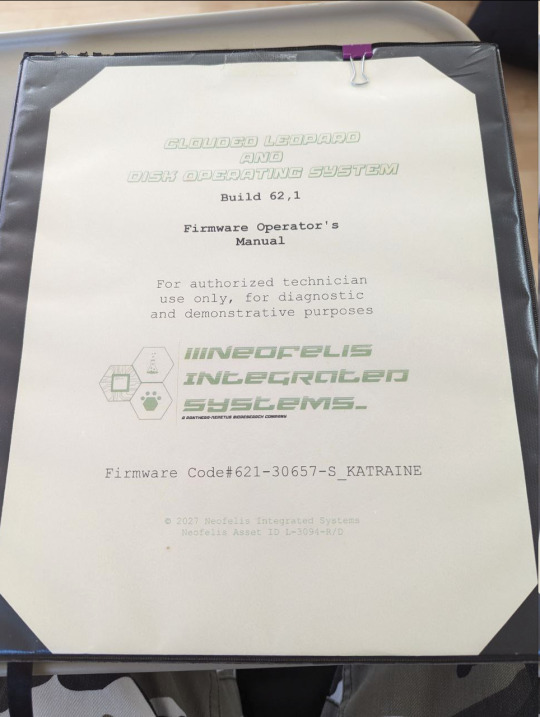
Neofelis Integrated Systems is imagined to be a prominent industry leader in the electronics integration and cybernetics field, that is rumored to dabble in biosynthetics and synthetic intelligence development, but these rumors are unsubstantiated outside of the company. In reality they're a Bit Fucked beneath the surface.

Opening the cover, numerous post-its are scattered on the interior, to help sell the idea that this manual existed in a real working environment. An extra LOTO tag is included in the manual, Just In CaseTM
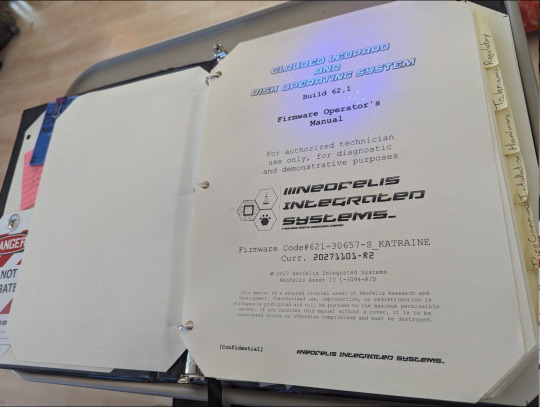
The interior title page mirrors the outer cover, but with some additional information. Numerous pages within this project are also dotted with UV reactive EUrion constellations to depict anti-duplication measures.
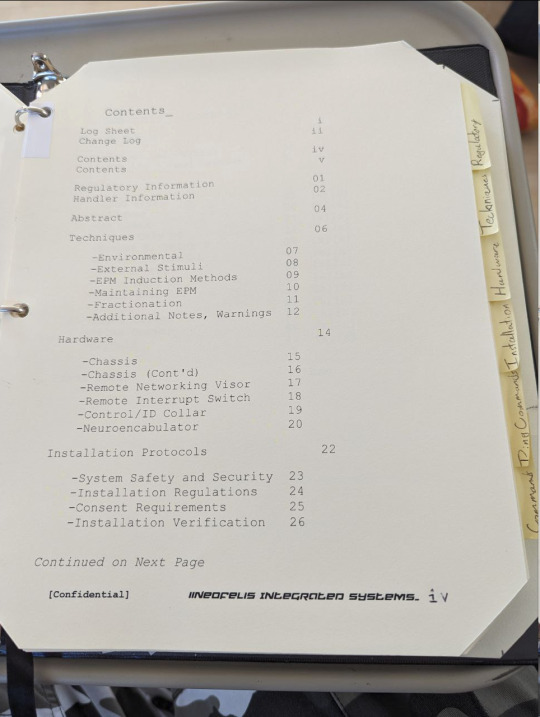
Contents 1/2. The second half won't be shown here because Reasons. EPM here refers to Elevated Permissions Mode -wiggle eyebrows-
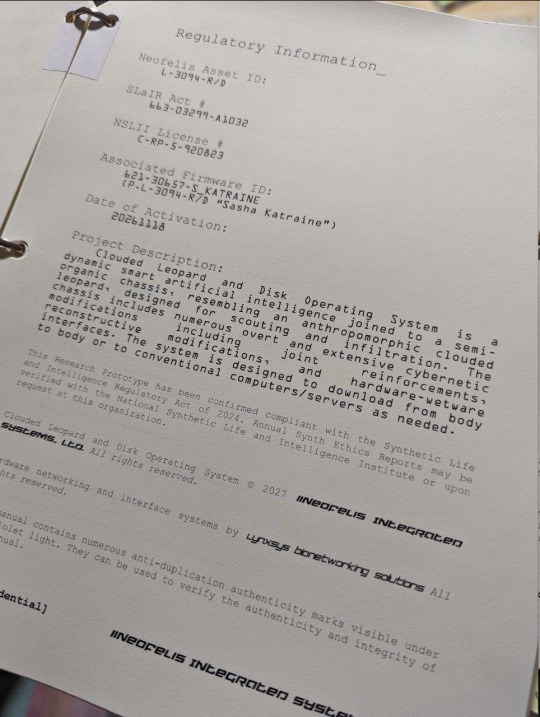
You can't just design and construct synth prototypes without proper regulation. That just won't do. Everything is definitely above board here.
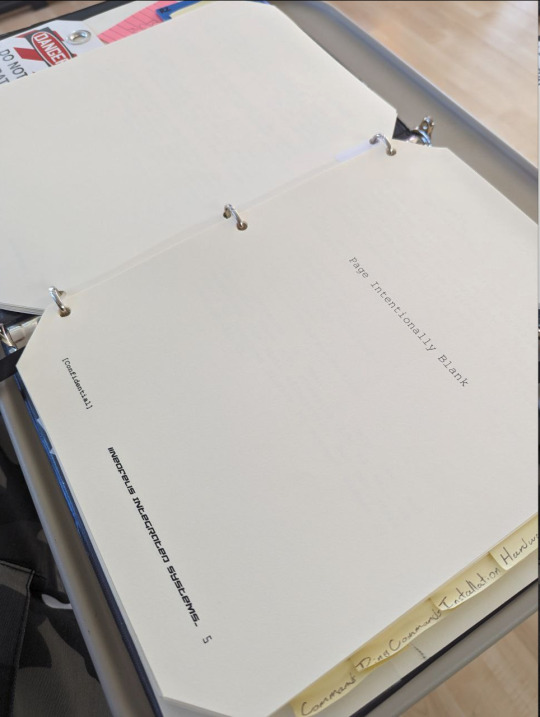
These pages are just such a vibe. I can't help but add them between sections.
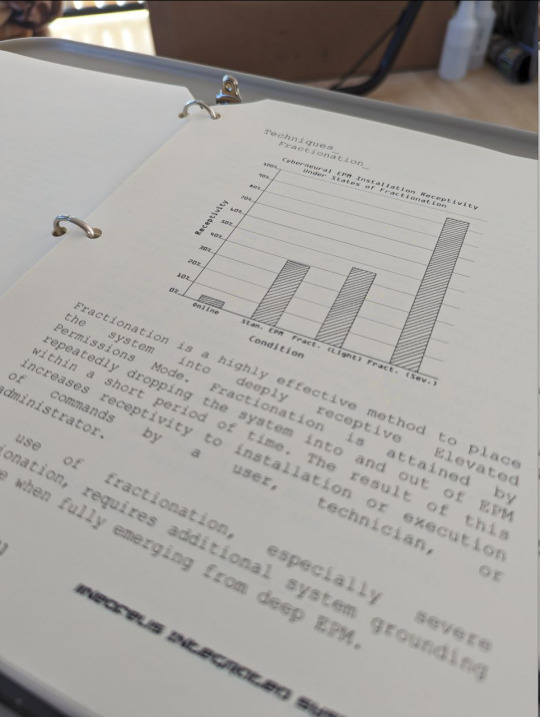
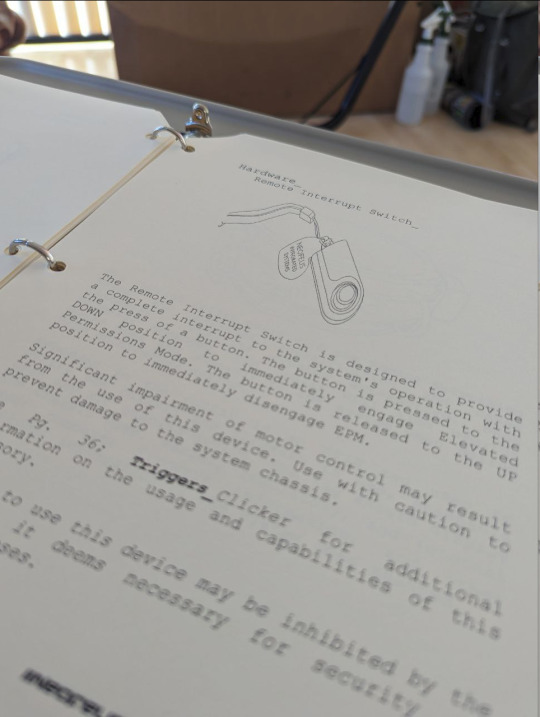
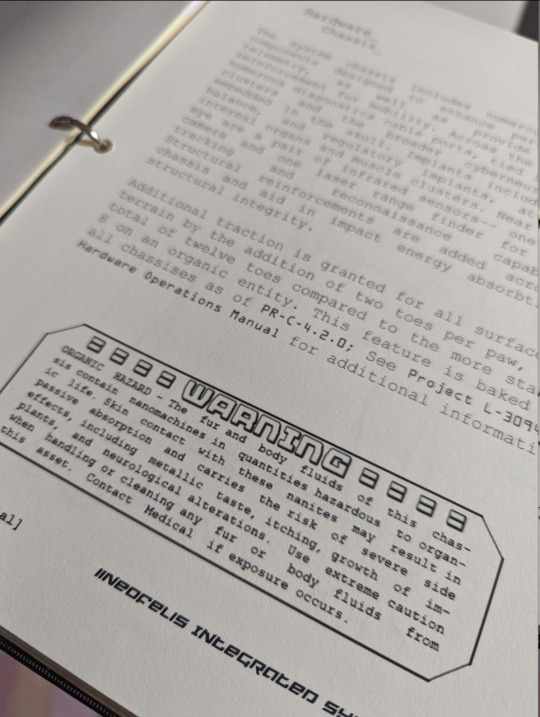
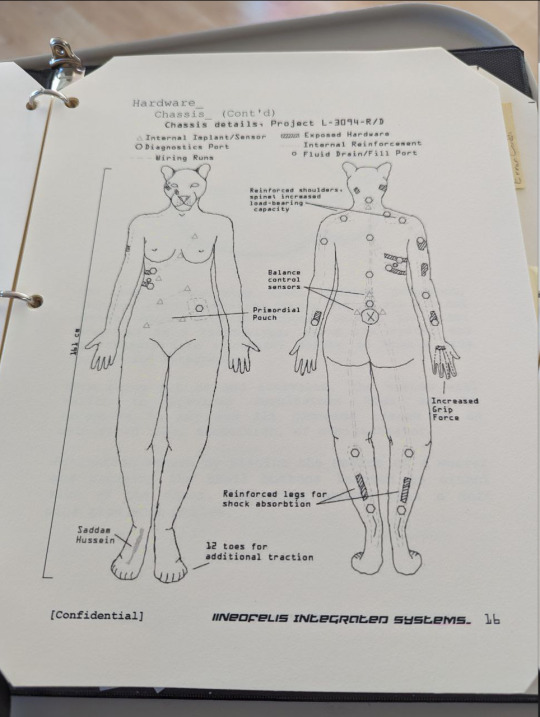
There are a few graphics that were made and sprinkled into this project to really fuel the software manual vibe. The chassis diagram in the print copy is now out of date, slightly. Also, never miss an opportunity to hide memes in a creative kink project. We like easter eggs.
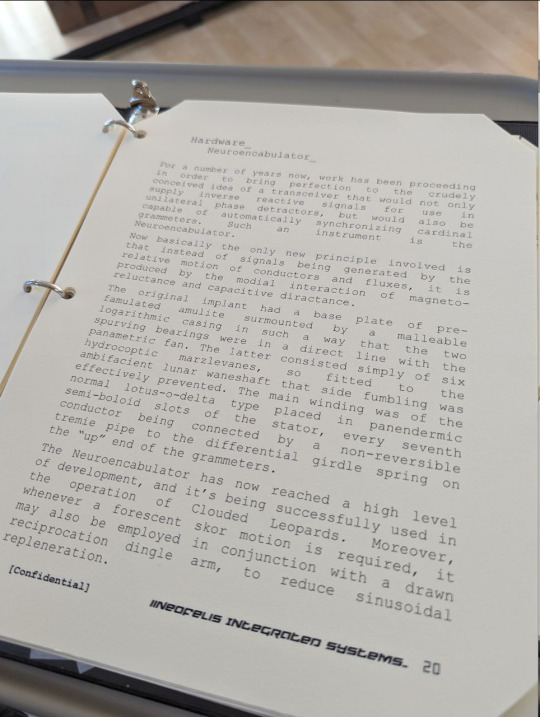
Beyond this there's complete sections regarding ethics and safety (some of which is genuinely important SSC/RACK info, because that's important), and the sections containing various hypno commands, which will not be shared openly for obvious reasons. There's also the Error Codes page at the back, full of error codes I really have not bothered to memorise admittedly.
Anyways, that's all to share. Questions are encouraged though!
329 notes
·
View notes
Text
There are three projects that I consider some of the hardest in computer science:
Compiler - Requires tons of text parsing, type system configuration, and code generation. A conglomerate of data flow.
Operating system - Build everything from the ground up. You don't even start with an allocator. Implement. Everything.
Browser - So many standards need to be implemented, it's a feat of graphics programming. Just the SVG specification is 900 pages.
If I'm missing anything on that same level of difficulty, let me know.
Some things people have mentioned:
X11 Standard: Not 100% sure why, but I'd assume an entire windowing/desktop environment interface would be crazy. From light research, I found that there seems to be a lot of backwards compatibility, and that Wayland is just more straightforward.
Emulators: Simpler consoles like the NES would already be substantial to emulate, let alone something like the Switch or PS5.
Physics engines: So much math. Raycasting, collisions, islands, and much more. And if you don't get it right, everything literally just explodes.
106 notes
·
View notes
Text
"INTERFEARANCE" Haunted house concept!
Interfearance is an HHN house concept that features original characters from popular creators and newer artists in the fandom. The story is that a group of criminals taking up the mantles of the original four icons hijacking a museum tour and terrorizing the employees and guests alike. All artists will be credited in this post. Thank you ❤️
This post contains minor but still prominent graphic content. (And most likely very corny lines) If you are freaked out by topics such as murder or other horror themes like this, PLEASE do not look through the haunted house concept. some words will be replaced with others to avoid triggering Tumblr's banning system. Second disclaimer: This is only concept art and I do admit my style is a bit cartoony for this topic, Its my first time making one of these and you will have to know these characters before hand in order to get a better understanding.
𝐼𝒩𝒯𝐸𝑅𝐹𝐸𝒜𝑅𝒜𝒩𝒞𝐸

After going through the house's queue, You will find yourself at the front of a museum. Once entering, you are met with a tour guide giving a description of "Fear's Lantern" and the history of Carey, Ohio's most infamous mysteries. All seems neutral until two hands bust through behind the information board and strangle the guide with a wire. The victim struggles before passing out and sliding down, leading for the gloved hands to grab the intercom to them from behind the hole. The lighting dims with a red hue as the lantern glows.
"We're sorry for the interruption, but You folks are going an alternate route through our newest exhibits!"

You move pass the introduction and enter into the first section of the maze, an outdoor environment themed to a carnival in progress of being set up, scareactors in clown makeup walk up and down aside the trail while holding weapons, Near by the entrance is a victim tied to a wheel, being spun around by Poprox the clown! Clearly there's been moderations made to his weapon of choice..
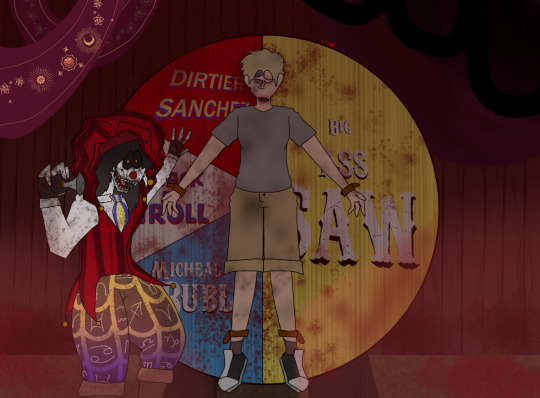
On the other side of the trail, before exiting this segment, You are face to face with the new ringleader of the maniac's operation, Mumbles! Standing on a crate-made-stage, looming over everyone passing by, reaching out just to get a spook out of them.
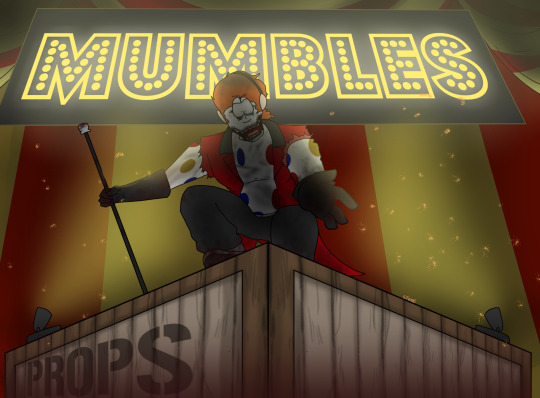
The next segment transitions from circus to manor as you enter through the second entrance, a sign on the wall points towards the morgue, ran by Dr.Caine, Her morgue unlike her father's is revamped, similar to that of a modern hospital. Everything is lit with blacklights as the surgeon inspects her newest live autopsy.
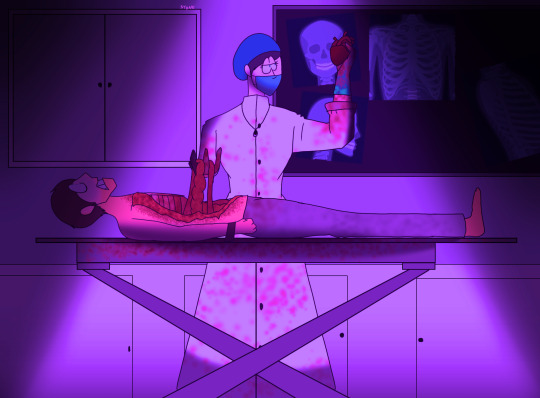
Passing by the procedure, before you head out of the morgue, you walk aside a wall adorned with skeletons of various animals. Rat emerges from a black curtain space next to the skeletons with a flashing light queue

Once exiting this segment, the environment changes from hospital to a grimy poolroom, There's blotches and bloodstains sprinkling the walls until you get to a room with Starlet and a recent actor turned victim who is being used for a remake of one of the Director's most infamous projects, "The Widow's Eye (This specific victim will be important later)
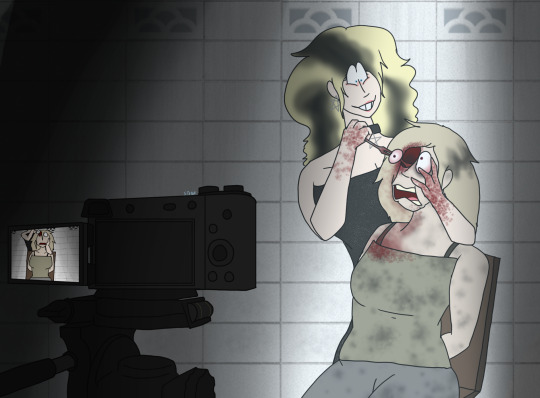
Once leaving Starlet's segment, you enter an abandoned structure, obscured with fog and humming coming from the middle of the section. There's a dried up fountain in Fear it self's image, covered in vines and cracks glowing underneath, the vines are all broken off at the hands as if it was holding something before. There is one character here which could be either Poproz, Rat, or Starlet. These characters alternate out with eachother.

After getting around the statue, you enter the final segment, the environment now resembles a small makeshift theatre with hand puppets decorating the walls, you pass by a small theatre and a dragon puppet, Stone, greets you, the interaction ends however, once the lights start flashing and the curtains unveil showing the person behind the puppet, Gracie, as she strikes with a pair of scissors.
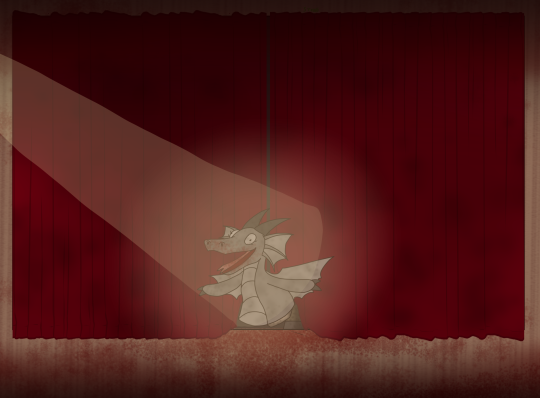
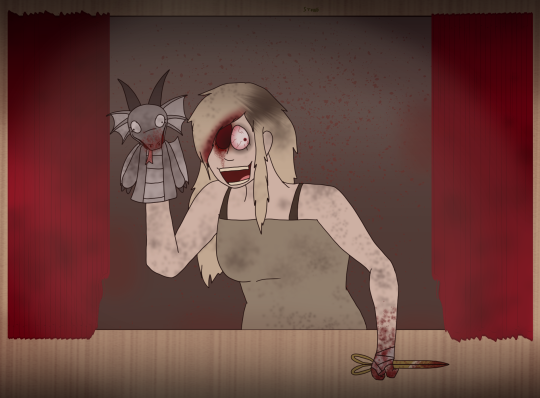
CREDITS
@thearoclown - Poprox
@chainsawb0y - Mumbles
@corzoli - Rat
@overlookedhotels - Starlet
Me! - Stone and Gracie
Cindy belongs to Universial Studios
Fire header - @animatedglittergraphics-n-more
#halloween horror nights#hhn#hhn icons#haunted house#maze#concept art#fan project#original characters#fanmade
26 notes
·
View notes
Text
ESSAY: My Hearthome in ABZÛ
by Ocean Watcher from House of Chimeras (He/they) I was inspired to write this essay after attending the panel, "No Place Like Home: On Hearthomes" at Othercon 2024 Note: This won't be the official home of this essay. I'm planning on adding it to our system's website, The Chimeras Library sometime in the future either as a standalone essay or part of something bigger.
My Hearthome in ABZU
by Ocean Watcher from House of Chimeras Date Written: 15 August 2024 Approx. Word Count: ~2,180
Approx. Reading Time: ~17 minutes
“They say home is where the heart is, and for most people it consists of four walls and a welcome mat. For me, it’s the ocean.” ~ Bethany Hamilton, Soul Surfer. Directed by Sean McNamara. California: Sony Pictures Releasing, 2011.
Defining Hearthome
A hearthome is a location, whether real or otherwise, that an individual has a strong emotional connection toward to the point it feels like a “home,” typically despite never having lived or spent a significant amount of time there. The specifics on what qualifies as a hearthome within this general definition is largely up for personal interpretation.
The location in question can be as all-encompassing as a whole planet all the way down to something much, much smaller. The location could be a real place (whether that be one that still currently exists or a location that once existed but doesn’t anymore), a setting depicted in fictional media, or something else entirely. It can also be a specific easily named location or merely a general description of a place. Finally, the exact kind of emotional connection and feeling like “home” a location can elicit can range from a feeling of familiarity, of comfort and relaxation, safety, nostalgia, homesickness, and/or more. In short, within the definition of hearthome there are many possibilities on how the experience can exist.
The term used to describe someone who has a hearthome or the state of having a hearthome is sometimes called hearthic, though not everyone uses it. (So, for example someone might say “I have a hearthome in [insert place here]” rather than saying “I am [insert place here]hearthic.” Whether hearthic is used or not alongside the term hearthome is largely personal preference.
Describing ABZÛ
ABZÛ (also written as Abzû) is a video game initially released in 2016. The game fits within several genres including adventure, simulation, and art video game. It has no dialogue and so the story is told solely through visuals. The main draw of the game is the graphics put into the diverse ocean environments and the wide range of marine life that inhabits each area. Most of ABZÛ is home to animal species that can be found in today’s oceans; however, there are over a dozen or so species that appear in the game that went extinct a long time ago.
The gameplay itself consists of the player controlling an android diver exploring a large variety of ocean environments in a vast ocean and getting to see a myriad of marine life at every turn.
Knowing the backstory of what occurs isn’t needed, but for some context: Deep at the bottom of this ocean was a primordial source of infinite energy. Where the energy permeated from the ground life spontaneously came into being. An ancient civilization discovered they could collect and use it to create (marine) life whenever and wherever they wished. However, at some point, they created machines to automate the process. The creation of these machines caused a disruption of the natural flow of life as they took up so much energy they drained the vitality of the ocean away. The civilization disappeared, leaving their machines to continue to operate. The objective of the player-controlled robot diver, another creation of the ancient civilization, is to return the energy back to the ocean and put an end to the machines causing the destruction.
ABZÛ is overall a short game, with most players seeming to complete it within an hour and thirty minutes to two hours, on average.
Home is Where the Heart Is Indeed
So, my hearthome is ABZÛ.
To start, I want to put some context between the game ABZÛ and my hearthome ABZÛ. The environments in the game are striking and hold an emotional importance to an extent that I have labeled it as a hearthome; however, the ABZÛ that I think of in my mind’s eye and thoughts is not just an exact mirror of the game. That is because the ABZÛ I have conceptualized in my own mind is laid out like a normal(ish) ocean thanks to some noemata I have.
The noemata I have reads that all the “game-y” elements necessary for it to function as, well, a game, aren’t present in the idea of ABZÛ that makes up my hearthome. So, all the things necessary to keep a player in a defined area and on a specific path are absent. Further, all the different locations shown in the game would exist in a much more natural way. Plus, even more biodiversity would exist than shown in the game itself (as it is only populated with a little more than a few hundred different species whereas a more realistic ocean would have tens of thousands). Basically, the concept of ABZÛ in my mind looks and functions a lot more like a natural ocean (if a much, much more vibrant and filled with even more aquatic life, one).
I also have noemata that reads that while the old structures of the civilization still exist in a way like how they appear in the game, the inverted pyramid machines have long broken down and been reclaimed by the ocean and there are no unnatural dead zones. (So, I guess, one could say my hearthome is based off how things look at the end of the game.)
So, there is all that.
That is all well and good, but now I want to cover why exactly I distinguish ABZÛ as a hearthome; why I feel it warrants a special label of significance to me at all.
Not to state the obvious, but games are meant to be emotionally and/or mentally moving. They are meant to make a player feel something. ABZÛ is no different. It is meant to be a “pretty ocean” game, if you will. The environments in ABZÛ certainly reflect a more idealized and concentrated concept of ocean life (the magnitude of marine life at any particular point in the game itself being far more than an ecosystem could sustain). So, of course, the game is meant to be visually stunning and calming (save for a section in the game roughly 3/5ths in) in relation to the ocean, but my feelings for the game go deeper than what would be normally expected.
It is true that much of the allure I have toward ABZÛ could be dismissed as merely as a natural consequence of my alterhumanity being so immersed in the ocean if not for the fact there are aspects of ABZÛ that draw out emotions and noemata that can’t be easily waved off in that manner. There are plenty of ocean-themed games and whatnot, yet it’s this specific one I have this connection toward. I have no idea why exactly I have a hearthome in this game specifically. I couldn’t tell you why. For whatever reason, its ABZÛ that resonates with me so strongly.
The biggest thing that stands out for me is the fact the area in the game that holds the most profound feelings of familiarity and belonging is the underwater city. At one point in the game, some underwater caves open into a vast underground space where a half-submerged city exists. (My view of things through some more noemata looks a lot more like an ancient city proper because, again, ABZÛ is a game so what exists is a lot more simplified and limited.) It is a city abandoned and in ruins and yet every surface is still covered in tile and brick of beautiful blue hues. Plants like trees, flowers, and vines populate the space above the water, lily pads and other floating plants pepper the water’s surface, and below sea plants like kelp, sea grass, and so much more cover much of the floor. Sunlight shines down from high above; my noemata filling in with the idea the city resides within a long extinct volcano rising above the ocean’s surface. Animals are everywhere both above and below the water. It’s this place I gravitate towards the most.
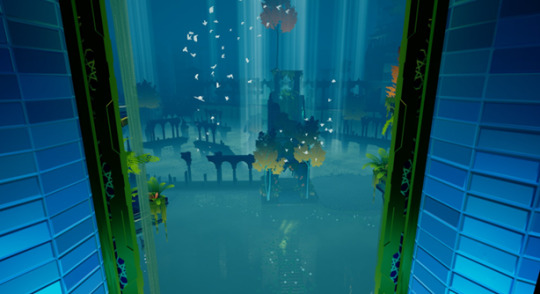
But what exactly do I feel?
Something about it resonates with me. It is a place that feels like home to a part of me. Something about it feels deeply right and missed despite never having lived there nor do I feel like it is a place I am “from,” in any specific way. The feelings my hearthome draw out of me can mostly be best described as comfort, relief, safety, and rightness. There is something familiar about it, even upon my first playthrough. There is maybe even a tinge of nostalgia even though I strongly feel like there isn’t anything past-life-like at play as to why I have this hearthome. It just feels so familiar and comforting to me.
Starting out, my feelings also included what I can best describe as a yearning or longing to want to be there, even if only to visit. There was a desire to know a place like it with my own eyes as much as I knew it already in my heart somehow. So, there was a bit of almost homesickness there too. All these feelings are described in the past tense because of something that happened a bit after first playing the game.
Sometime after first playing ABZÛ, a sunken city with strong similarities to the one in the game was discovered in the ocean in our system’s innerworld. It is not a perfect exact copy, but it has all the same elements and looks how my hearthome appears through the lens of the noemata I have. I know I didn’t consciously will the location in our innerworld to come into existence, no one here can make such blatant conscious changes to our innerworld; however, I’m far less certain if my discovery of the game and the emotions it elicited didn’t cause the sunken city to appear in our innerworld as an involuntary reaction. (Not long after its appearance, several other areas in the game also found their way into the ocean of our system’s innerworld.) Since its appearance and discovery, I spend much of my time in these impacted areas, especially the sunken abandoned city. Since its appearance, the location has become a much beloved place to be, not just for me but also for many other aquatics in the system. The area is aesthetically pleasing and interesting to move around in. There is a lot of wildlife so hunting instincts can be indulged and so on. When not focused on fronting it is a nice place to exist in.
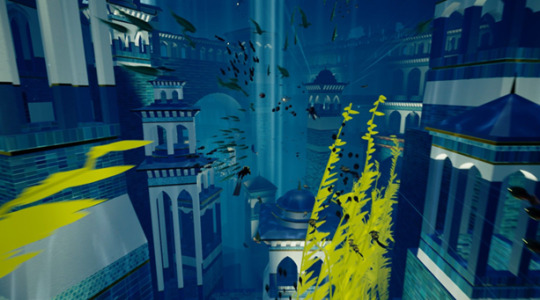
I’ve been aware of my emotional connection to the setting depicted in ABZÛ since July 2018 after playing it for the first time. Since buying it on Steam, I’ve logged many hours on it and have played through its entirety several times. However, I had not labeled my feelings towards this game as a hearthome until recently. Back then, I never questioned or analyzed my feelings surrounding the environments in the game. I knew it soothed something in me to play the game, going out to the sunken city in the innerworld for a while, or even just imagine myself swimming in one of my favorite areas, but I didn’t think about why exactly that was the case.
I didn’t make the connection between my experiences with ABZÛ to the term, hearthome until August of 2024. The moment of realization came while listening to the panel, “No Place Like Home: On Hearthomes” at Othercon 2024. Upon Rani, the panel’s host, describing the meaning of the term, I realized my feelings towards ABZÛ fit perfectly within the word. It wasn’t even a particularly jarring realization, and I am not sure how I had never made the connection before. Since that realization, I’ve come to label my feelings around the game, ABZÛ as my hearthome.
On the topic of alterhuman terms, I don’t use the term hearthic to refer to my state of having a hearthome at this time, solely because the word just doesn’t feel right when I try to use it in context. That could change, but for now, that is that.
I do consider my hearthome to be a part of my alterhumanity. My hearthome certainly fits neatly into my wider alterhumanity; ocean life and all that. That being said, I don’t think my hearthome has as strong of an impact on my daily experiences as other aspects do. My feelings around my hearthome are most often closer to something in the background more than anything. It is still there, and it is still important, it is just not as blatant and impactful in my daily life compared to something like my phantom body from my theriotypes. The fact parts of the game now exist in the innerworld and are prime locations for me to go after fronting to alleviate species dysphoria is perhaps the most blatant way my hearthome impacts my greater alterhumanity.
Bibliography
505 Games, ABZÛ. 505 Games, 2015, Microsoft Windows.
“Glossary,” Alt+H, https://alt-h.net/educate/glossary.php . Archived on 19 Apr 2020: https://web.archive.org/web/20200419100422/https://alt-h.net/educate/glossary.php
Lepidoptera Choir. “Hearthic” astrophellian on Tumblr. 9 April 2022. https://astrophellian.tumblr.com/post/681107250894503936/hearthic . Archived on 30 September 2022: https://web.archive.org/web/20220930143533/https://astrophellian.tumblr.com/post/681107250894503936/hearthic
Rani. “No Place Like Home: On Hearthomes,” Othercon 2024, 11 August 2024, https://www.youtube.com/watch?v=lYVF_R6v50Q
43 notes
·
View notes
Note
could you explain for the "it makes the game go faster" idiots like myself what a GPU actually is? what's up with those multi thousand dollar "workstation" ones?
ya, ya. i will try and keep this one as approachable as possible
starting from raw reality. so, you have probably dealt with a graphics card before, right, stick in it, connects to motherboard, ass end sticks out of case & has display connectors, your vga/hdmi/displayport/whatever. clearly, it is providing pixel information to your monitor. before trying to figure out what's going on there, let's see what that entails. these are not really simple devices, the best way i can think to explain them would start with "why can't this be handled by a normal cpu"
a bog standard 1080p monitor has a resolution of 1920x1080 pixels, each comprised of 3 bytes (for red, blue, & green), which are updated 60 times a second:
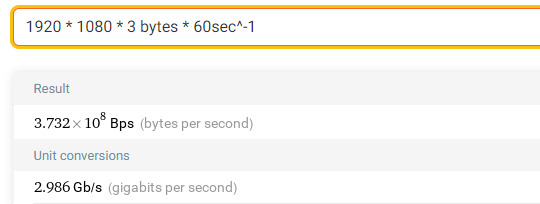
~3 gigs a second is sort of a lot. on the higher end, with a 4k monitor updating 144 times a second:
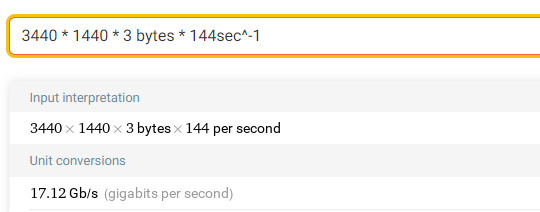
17 gigs a second is definitely a lot. so this would be a good "first clue" there is some specialized hardware handling that throughput unrelated the cpu. the gpu. this would make sense, since your cpu is wholly unfit for dealing with this. if you've ever tried to play some computer game, with fancy 3D graphics, without any kind of video acceleration (e.g. without any kind of gpu [1]) you'd quickly see this, it'd run pretty slowly and bog down the rest of your system, the same way having a constantly-running program that is copying around 3-17GB/s in ram
it's worth remembering that displays operate isochronously -- they need to be fed pixel data at specific, very tight time timings. your monitor does not buffer pixel information, whatever goes down the wire is displayed immediately. not only do you have to transmit pixel data in realtime, you have to also send accompanying control data (e.g. data that bookends the pixel data, that says "oh this is the end of the frame", "this is the begining of the frame, etc", "i'm changing resolutions", etc) within very narrow timing tolerances otherwise the display won't work at all
3-17GB/s may not be a lot in the context of something like a bulk transfer, but it is a lot in an isochronous context, from the perspective of the cpu -- these transfers can't occur opportunistically when a core is idle, they have to occur now, and any core that is assigned to transmit pixel data has stop and drop whatever its doing immediately, switch contexts, and do the transfer. this sort of constant pre-empting would really hamstring the performance of everything else running, like your userspace programs, the kernel, etc.
so for a long list of reasons, there has to be some kind of special hardware doing this job. gpu.
instead of calculating every pixel value manually, the cpu just needs to give a high-level geometric overview of what it wants rendered, and does this with vertices. a vertex is very simple, it's just a point in 3D space, for example (5,2,3). just like a coordinate grid on paper with an extra dimension. with just a few vertices, you can have models like this:
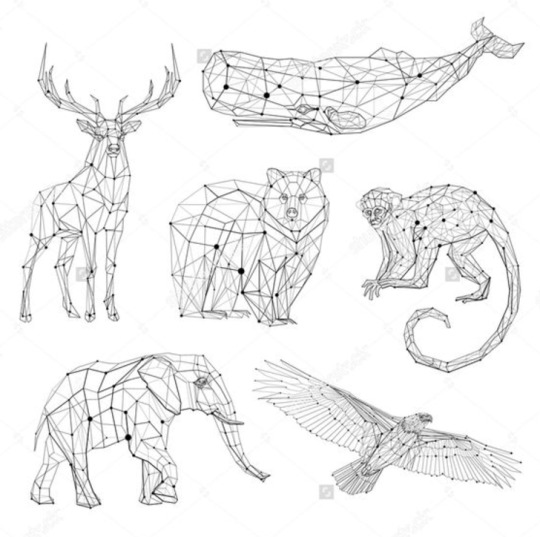
where each dot at the intersection of lines in the above image, would be a vertex. gpus essentially handle huge number of vertices.
in the context of, like, a 3D video game, you have to render these vertex-based models conditionally. you're viewing it at some distance, at some angle, and the model is lit from some light source, and has perhaps some shadows cast across it, etc -- all of this requires a huge amount of vertex math that has to be calculated within the same timeframes as i described before -- and that is what a gpu is doing, taking a vertex-defined 3D environment, and running this large amount of computation in parallel. unlike your cpu which may only have, idk, 4-32 execution cores, your gpu has thousands -- they're nowhere near as featureful as your cpu cores, they can only do very specific simple math with vertices, but there's a ton of them, and they run alongside each other.
so that is what a gpu "does", in as few words as i can write
the things in the post you're referring to (V100/A100/H100 tensor "gpus") are called gpus because they are also periperal hardware that does a specific kind of math, massively, in parallel, they are just designed and fabricated by the same companies that make gpus so they're called gpus (annoyingly). they don't have any video output, and would probably be pretty bad at doing that kind of work. regular gpus excel at calculating vertices, tensor gpus operate on tensors, which are like matrixes, but with arbitrary numbers of dimensions. try not to think about it visually. they also use a weirder float. they're used for things like "artificial intelligence", training LLMs and whatever, but also for real things, like scientific weather/economy/particle models or simulations
they're very expensive because they cost the same, if not more, than what it cost to design & fabricate regular video gpus, but with a trillionth of the customer base. for every ten million rat gamers that will buy a gpu there is going to be one business buying one A100 or whatever.
⎯⎯⎯⎯⎯⎯⎯⎯⎯⎯⎯⎯⎯⎯⎯⎯⎯⎯⎯⎯⎯⎯⎯⎯⎯⎯⎯⎯⎯⎯⎯⎯⎯⎯⎯ disclaimer | private policy | unsubscribe
166 notes
·
View notes
Text
Freedom Wars Remastered announced for PS5, PS4, Switch, and PC - Gematsu
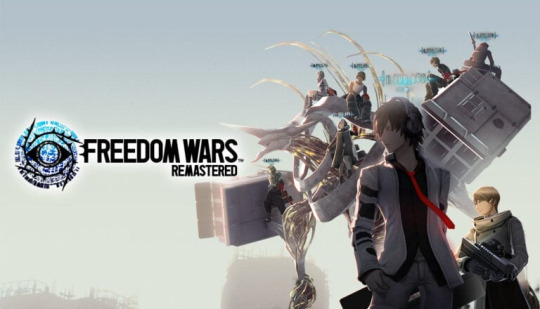
Publisher Bandai Namco and developer Dimps have announced Freedom Wars Remastered, a remastered version of Sony Interactive Entertainment‘s 2014-released PS Vita action RPG including previously released downloadable content. It will launch for PlayStation 5, PlayStation 4, Switch, and PC via Steam on January 10, 2025.
Here is an overview of the game, via Bandai Namco:
About
For the crime of existing, your 1,000,000-year sentence begins today. In a dystopian future, the world is ravaged by pollution and depleted of natural resources, and humanity lives in sprawling prison complexes called Panopticons. Anyone born into this hellscape are deemed “Sinners.” Players seek their freedom by volunteering for extremely dangerous combat operations to compete with other Panopticons for what remains of the planet’s dwindling resources.
Key Features
Deep Character Customization – Create a unique look that reflects your style with a vast array of options, from facial features to clothing and accessories. Tailor your weapon loadouts and gear to suit your gameplay preferences. Stand out in the fight for freedom!
Elevated Experience – Freedom Wars Remastered brings enhancements such as 4K resolution, upgraded textures, and 60 frames per second performance on PlayStation and PC, an overhauled weapon crafting system and other game playupgrades, as well as adding difficulty settings. Improved graphics bring environments and characters to life, while refined controls ensure more responsive and intuitive gameplay.
Exhilarating Cooperative Battles – Join forces with up to seven players in Freedom Wars‘ cooperative mode. Work together to rescue citizens and take down massive Abductors in fast-paced, action-packed missions. With dynamic teamwork and strategy, you’ll face ever-evolving challenges that demand skill, coordination, and quick thinking.
In an interview with PlayStation Blog Japan, Takashi Tsukamoto, director of the original Freedom Wars at Dimps, as well as development producer of Freedom Wars Remastered, said, “We’ve wanted to make a sequel ever since the game was released 10 years ago, but the opportunity never came up. This time, we were fortunate enough to have that chance, and with Bandai Namco Entertainment producing while we develop, and with it being the 10th anniversary, the timing was right to do something.”
When asked why Freedom Wars Remastered is being published by Bandai Namco when the original game was published and still owned by Sony Interactive Entertainment, Tsukamoto said, “When we [Dimps] received the license from Sony Interactive Entertainment to create a remastered version and were looking for a publisher, Bandai Namco Entertainment kindly stepped forward and offered to publish.”
Here is a comparison between the original game and the remastered version:
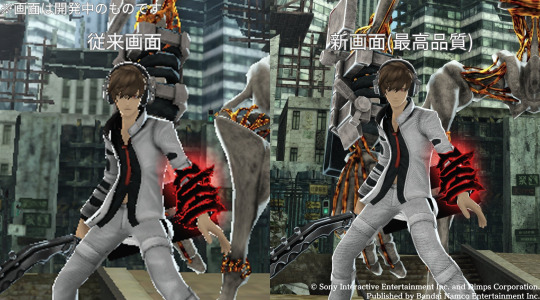
Watch the announcement trailer and first gameplay footage below. View the first screenshots at the gallery.
Announce Trailer
English
youtube
Japanese
youtube
Gameplay
Famitsu
youtube
#Freedom Wars Remastered#Freedom Wars#Dimps#Bandai Namco#Gematsu#Heck yeah. Wonder if they'll add anything to it?#Oreshika next please?#Youtube
23 notes
·
View notes
Text
And the penal colony was to remain a viable alternative to the penitentiary, not only in nineteenth-century Britain, but also in twentieth-century France [...]. But what might it mean to have a rigorous and distant form of imprisonment, located in a colony and continuing until the mid–twentieth century? [...]
---
French Guiana emerged as an early favorite for the placement of a French penal colony. [...] Daniel Lescallier [...] authored a work entitled [...] (Exposition of the means by which to develop French Guiana). In it he points to the example the British have set in exporting offenders to the colonies [...]. Louis-Napoleon, still serving in the capacity of president of the republic, threw his weight behind [...] the exile of criminals as well as political dissidents. “It seems possible to me,” he declared near the end of 1850, “to render the punishment of hard labor more efficient, more moralizing, less expensive [...], by using it to advance French colonization.” [...] The era of the French penal colony was now open; the new French Empire had begun its Botany Bay, even as the British original [penal colony in Australia] wound to a close. [...] The double logic of the British system also drives the French imagination; proposals alternatively concentrate on a desire to punish criminals and rid the Metropole of their presence, on the one hand, and a hope of furthering the work of colonial expansion and economic progress, on the other. Within this logic the focus shifts between the need to colonize, the need to punish [...].
In the case of France, it shimmers with colonial fantasy, allowing future Australias to emerge on tropical horizons. [...] [T]he penal colony requires location. The specificity of the site matters; it is the very place that is to enact punishment [...]. The penal colony is in essence a geographic technique [...]. But despite frequent outcries and sensational reports, the French Guiana penal establishment continued to exist through the end of World War II. [...] As geography itself becomes a technique of isolation, the French penal experiment in Guiana threatens further ordeals implicit in separation from all that is civilized. [...] In sensational accounts these tropics incessantly punish [...]: “Fever and dysentery get every man! Clouds of buzzing mosquitoes and fire ants sting your aching body while you labor [...].” As the commandant of the bagne would inform convicts on their arrival, “The real guards here are the jungle and the sea.” [...] Many of the prisoners, after all, were from urban environments [...]. The terror of Devil's Island takes shape amid metaphoric invocations of the jungle and of the savage [...].
---
For those in Metropolitan France the penal colony served as a hidden punishment, a distant if graphic terror, retaining elements of torture out of public view. Yet it retained a veneer of reformation, for the convicts were still told to “make a new life for themselves.” In addition, shipping convicts away from France in the name of colonization cloaked their punishment in the robes of the “civilizing” mission: they would be part of an effort to build a greater France, to develop Guiana, and to integrate it into a Franco-world system. At the same time the bagne underscored that resistance to the humane norms of France could lead to decivilization and exile in the wilderness. [...]
---
For those sent to French Guiana, however, the penal colony served directly as a public display, a constant reminder of the operations of justice. The convicts were not merely confined but forced to labor on public works. Official executions were performed by that once-humane instrument, the guillotine, but before an audience of convicts and by a fellow convict, far beyond the gates of Paris. A slower execution, that of the “dry guillotine,” the effects of the tropical climate, surrounded the entire process of deportation, reminding the convicts that this punishment could only happen here and not within Metropolitan boundaries. Theirs was a raw and primitive environment, one of torture and deprivation away from the public eye. Against the truth invoked in their conviction - justice - lay a suggested truth invoked in their punishment: no longer civilized, they were no longer human.
---
And for those already living in French Guiana, the penal colony also served as a public spectacle, if one not aimed directly at them or of their making. Not only did the proximity of prison life to their own lives parade the power of justice before them in an immediate fashion, but the constant importation of prisoners for this apparatus of punishment emphasized the particularly colonial nature of this power. Uncivilized elements were sent to them; their relation to France was that of a repository for human waste, and acts and punishments deemed unseemly for the homeland could still occur within their boundaries.
In addition, the appropriation of the names “Guyane” and “Cayenne” in myths of the bagne and “Devil's Island” precluded other identities, while burdening the area with a symbolic brand and a historical chain to France. “The bagne,” writes Ian Hammel, “left only a disastrous brand on Guiana.”
Brand here means “trademark” as well as “scar,” indicating purpose, function, and maker.
To be remembered as a penal colony is to be remembered not only as a prison, an exotic place of horror, but also as a colony, the object and product of another. [...] Modernizing France, a convulsive patchwork of provinces, cities, farms, and factories, casts its shadow overseas. [...] The penal colony takes shape at a crucial moment in European colonial understandings of place and labor. Slavery had just been abolished in the French Empire […]. If slavery were at an end, then the crucial question facing the colony was that of finding an alternative source of labor [...], not only in French Guiana, but also throughout colonies built on the plantation model.
---
All text above by: Peter Redfield. Space in the Tropics: From Convicts to Rockets in French Guiana. 2000. [Bold emphasis and some paragraph breaks/contractions added by me. The text shown here comes from several different chapters in Redfield’s book, shown in the order that they originally appear. Presented here for commentary, teaching, criticism purposes.]
#abolition#ecology#forests#imperial#caribbean#colonial#landscape#haunted#futures#modernity#french algeria#carceral#geographic imaginaries#tidalectics#archipelagic thinking
162 notes
·
View notes
Text






















11.04.25
We went to Reade Signs in Aldershot today!
We went to have a meeting about posters at the Abbey School with Andy.
Reade Signs use iMacs for graphics and productivity work and Windows PCs for admin.
We met Scotty and Alex, who showed us the amazing printers in the workshop!
The printer, which is a 'VUTEk' LED hybrid printer, runs the Debian Linux operating system on an integrated Fiery controller.
The desktop environment for this Linux OS is a modified version of MATE, which is a modern version of the GNOME 2 DE.
The printer software running on this is VutekUI, used for managing client printing jobs. Vutek printers and software is managed by Electronics for Imaging (EFI).
Official Debian desktop wiki site:
https://wiki.debian.org/DesktopEnvironment
I had a go at operating the printer by pressing, Ready to Print!
See our previous visits in 2016 and 2017 here:
https://www.tumblr.com/bjsmall/140038522222/on-the-26th-of-february-chris-and-i-went-to-reade?source=share
https://www.tumblr.com/bjsmall/162556084377/030717-we-had-a-meeting-with-reade-signs-in?source=share
It was great to return to Reade Signs!
5 notes
·
View notes
Note
I just saw the ask by slushysblog. In response you sent a gif that blew me away:

You see, I'm just getting into digital art, and my PC can only handle about 5 or 6 layers before my graphics environment crashes. (Ofc this forces me to restart my PC and lose anything not saved.)
I've learned to work around this, my art isn't nearly so complex as yours, but I know if I want to continue I'll have to get a better computer at some point.
I was hoping you could tell me a bit about the technical side of your work. What are your PC specs? What software do you use? That sort of thing.
Thanks in advance! I love your art!
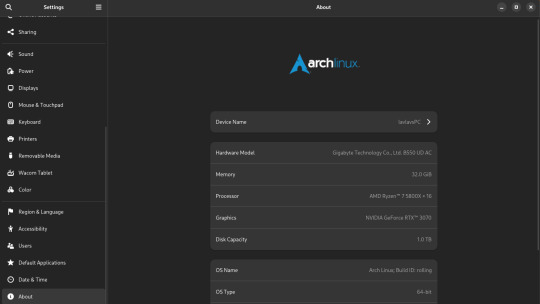
My set-up is complete overkill for art. It's a heavy gaming-ready desktop PC I got a few years back that I've upgraded the RAM and storage on over the years. I was doing fine with 16GB of RAM but I always have open a lot in CSP and other stuff so upgrading was definitely something I needed to do. 16GB should be fine for most people though.
You can also see that I run Arch Linux and uh yeahhhhhh it's a long story. The short of it is that my old laptop broke its Windows install during an update and I was completely unable to fix it so I just.... switched to Linux lol. I started out on Ubuntu and switched to Arch after a while. I don't rec using Arch unless you know what you're doing, Ubuntu is way easier.
What you might find more interesting is my away from home set up on my laptop since it's an older gaming laptop.
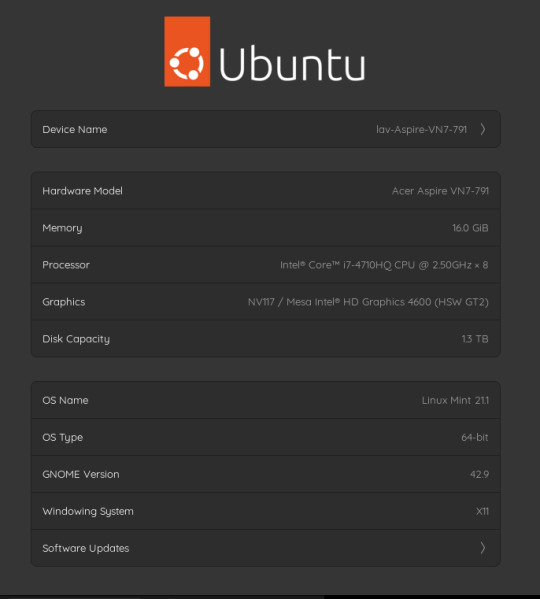
The graphics card is actually a NVIDIA Geforce 850 or something. It's so old that you can't play some games on it. However, I have no issues with it for art. I can open my comic project files in CSP fine on it. It's also running on Linux Mint, which isn't showing up on the little image for some reason. Both of my devices run Linux, but that's a me preference/need thing and I don't rec messing with your operating system if you don't know much about computers. It gives me a bit of an edge since the system doesn't use as much RAM as Windows but yeah don't touch unless you're committed to learn. Windows will serve you fine. Or MacOS even.
As for my program, I use Clip Studio Paint EX. I bought Pro a long time ago and upgraded to EX because of the extra tools for comics and animation (I've heard animators don't like CSP though, it's the BEST program for comics however). It's a really solid program but the recent changes to pricing and updates is really stupid. Fun fact: I use only default brushes and materials because getting it to run on Linux breaks the store. I also use an older version of it because of how I got it working on this system.
For my tablet I use an XP-Pen Artist 12 Pro. It's a pretty solid screen tablet on a budget (I bought it on a sale) and I have no issues with it. I actually partly got it because I thought it was cool that XP-Pen carries official drivers for Linux too, and this helped a bit since this was before Windows bricked on me and I switched to that. It was kinda weird how it played out lol. I would heavily not rec a Wacom tablet unless it's an older one for cheap. Wacom is stupidly expensive and you can get a better bang for your buck at other companies. My first tablet is a Wacom and it's still holding up pretty well but their quality on their new tablets isn't great. Check out XP-Pen, Gaomon, and Huion for better tablet options.
29 notes
·
View notes
Text

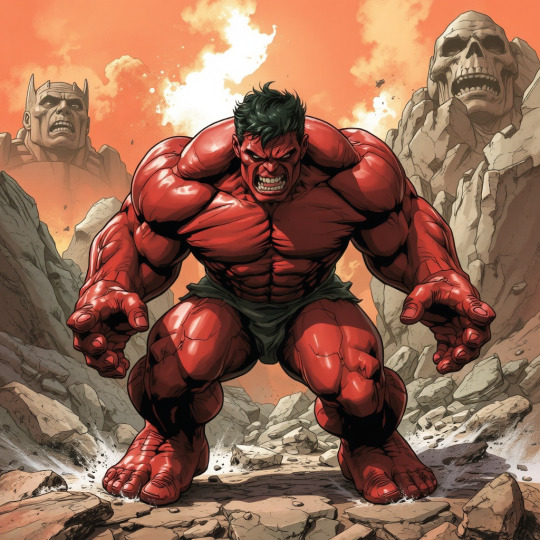
Game Description for Red Hulk: SMASH
Enter the world of raw power, destruction, and moral ambiguity in Red Hulk: SMASH, an epic action-adventure game exclusively for the PlayStation 7. As Red Hulk, you are a walking force of nature, driven by a fierce, unrelenting rage that only destruction can appease. Once a high-ranking military general, now transformed into an unstoppable powerhouse, Red Hulk grapples with his newfound monstrous abilities while facing enemies from all sides, including heroes, villains, and shadowy organizations that threaten global stability.
Red Hulk: SMASH isn’t just about mindless destruction; it’s a journey of strategic mayhem. Each mission presents unique environmental challenges and tactical puzzles that only Red Hulk's brutal strength can solve. Players will have to think as much as they smash, combining devastating combos, unique power-ups, and adaptive strategies to tear down enemies and obstacles alike.
Venture across war-torn landscapes, secret military bases, urban environments, and experimental labs, encountering iconic Marvel characters along the way. As the plot unfolds, Red Hulk must choose whether to be a weapon for the government, a rogue force of nature, or something more. Allies will prove to be just as dangerous as enemies, as Hulk must navigate alliances with other heroes and anti-heroes in the Marvel universe.
Can you control the rage? Or will you let it consume you? Embrace the power, face the darkness within, and prepare to SMASH your way to a new era of superhero games!
Features:
Dynamic Combat System: Utilize a range of powerful, destructible moves, chaining together devastating combos to bring down foes and entire buildings.
Environmental Destruction: Experience fully destructible environments, with physics-driven collapses, debris interactions, and enemy ambushes emerging from every corner.
Morality-Based Decisions: Shape Red Hulk’s path as an anti-hero or rogue agent, impacting missions, allies, and endings.
Iconic Marvel Cameos: Battle alongside or against familiar faces from the Marvel universe, including Hulk, Wolverine, and more.
Intense Boss Battles: Face massive enemies with unique abilities, each requiring Red Hulk’s strength and wit to overcome.
Upgrade and Evolution System: Customize Red Hulk's abilities with a deep upgrade system, unlocking new powers, resistance levels, and combat styles.
Next-Gen Graphics: Powered by the PlayStation 7, immerse yourself in hyper-realistic visuals with stunning lighting, particle effects, and seamless open-world environments.
Are you ready to unleash Red Hulk’s rage on the world?
To expand upon Red Hulk as an antihero within the world of #enXantingNoir and #TheeDarkKnight, let's craft a character profile that adds complexity and fits the darker, morally ambiguous tone of a noir-inspired Gotham. In this universe, Red Hulk could represent a wild card whose allegiance shifts based on personal motives and the greater balance of power, rather than traditional notions of good or evil. Here’s a deeper look into how we could integrate Red Hulk into this world, with elements inspired by both DC and Marvel's noir aesthetics.
Character Profile: Red Hulk (General Thaddeus "Thunderbolt" Ross)
Alias: Red Hulk, Code-Named Crimson Beast
Affiliations: Unpredictably aligned—sometimes assists The Dark Knight (Batman), other times coerced or hired by Gotham’s rogues gallery
Base of Operations: Gotham’s Industrial Quarters, known for factories and rusting warehouses—a stark contrast to Bruce Wayne’s world of high society
Backstory
In this #enXantingNoir universe, General Thaddeus "Thunderbolt" Ross, known as Red Hulk, finds himself in Gotham after a government "containment" experiment gone wrong. While initially tasked with capturing meta-human threats for the military, Ross’s transformation into Red Hulk was seen as a failure due to his uncontrollable nature. His exile to Gotham serves as both punishment and containment, as his presence alone acts as a deterrent to Gotham’s more uncontrollable criminals.
Ross was once a decorated general who viewed Gotham's criminal infestation with disdain, seeing it as a breeding ground for chaos that the federal government neglected. Now, as Red Hulk, he sees himself as a force capable of purging the city’s criminal underbelly. However, Gotham’s atmosphere has a way of corrupting those who enter its fold, and Ross soon finds himself torn between his own sense of justice and the lure of Gotham’s criminal underworld.
Character Dynamics
Relationship with The Dark Knight
An Uneasy Alliance: Batman, always wary of vigilantes who use brute force, sees Red Hulk as a necessary evil. They share a mutual understanding that Gotham is a city of shades of gray, where traditional moral boundaries are constantly tested.
Occasional Allies, Reluctant Rivals: Red Hulk’s penchant for destructive solutions puts him at odds with Batman’s more precise methods. While Batman relies on skill, fear, and strategy, Red Hulk represents raw power and the devastation he can unleash. However, Red Hulk respects Batman’s mental prowess and tactical skills, seeing in him a rare intelligence that is nearly on par with his own military acumen.
Confrontations with No-Win Scenarios: When they do clash, it’s because Red Hulk is willing to cross lines Batman won’t. This creates tense standoffs, where Batman might find himself strategizing just to control the beast within Red Hulk.
Relationship with Gotham's Rogues Gallery
The Criminals' “Nuclear Option”: Gotham’s villains, from Penguin to Bane, know the power Red Hulk possesses. Villains might attempt to manipulate or pay him off to remove certain obstacles or to serve as muscle, even though they know he’s as likely to turn on them as he is to help.
Targeted by Manipulative Minds: Characters like The Riddler and Scarecrow see Red Hulk as a potential pawn, constantly trying to manipulate or trap him to exploit his strength. Yet, because Red Hulk's mind is still intact despite his transformation, he resists most attempts at control—adding to his mystique and making him a target for psychological games.
Respect Amongst Physical Threats: Bane, Killer Croc, and Solomon Grundy see Red Hulk as the ultimate “warrior,” someone who may share their violent instincts but does so with purpose. They test their strength against him in brutal encounters, leading to scenes of pure spectacle and fury across Gotham’s back alleys and abandoned factories.
Powers and Abilities
Red Hulk's Powers and Abilities for Red Hulk: SMASHIn Red Hulk: SMASH, players will tap into the intense, destructive powers of Red Hulk, a character defined by his raw strength, adaptability, and relentless rage. Unlike the original Hulk, Red Hulk possesses unique abilities tailored to his specific physiology, background, and tactical approach to combat. Here’s an in-depth look at the powers and abilities players will wield in the game:---Core Abilities:1. Superhuman StrengthPower Description: Red Hulk’s strength rivals and often exceeds that of the Hulk, allowing him to lift, throw, or smash anything in his path. His strength scales with his anger, which means he grows even more powerful the longer the fight lasts.In-Game Mechanics: Players can level up Red Hulk’s strength as they progress, unlocking moves that allow him to throw larger objects (like cars, tanks, and even helicopters) or deliver powerful punches that can create shockwaves.2. Thermal Radiation EmissionPower Description: When enraged, Red Hulk begins to emit massive amounts of heat, capable of melting steel or causing combustibles around him to ignite. This heat is a double-edged sword; while it makes him deadly in close combat, it drains his energy and leaves him vulnerable if overused.In-Game Mechanics: Players can activate Heat Mode in bursts to deal intense damage to enemies within a radius. However, prolonged use causes an overheat effect, where Red Hulk’s health depletes slowly, forcing players to use this ability tactically.3. Rage AmplificationPower Description: Unlike Hulk, who becomes stronger with anger but less in control, Red Hulk’s rage amplifies his abilities while maintaining tactical precision. As he fights, his rage meter fills, allowing access to more advanced and devastating abilities.In-Game Mechanics: The Rage Meter fills as Red Hulk deals or takes damage. Once full, players can activate Rage Mode, giving Red Hulk access to special moves, faster attacks, and temporary invincibility. Rage Mode also makes him immune to stuns, allowing relentless offense.---Unique Abilities:1. Seismic Ground PoundPower Description: Red Hulk slams the ground with incredible force, creating a seismic shockwave that knocks down and damages all enemies within range. This move is especially effective in crowded enemy zones and can demolish obstacles.In-Game Mechanics: When activated, Red Hulk’s ground pound deals area-of-effect damage, stuns enemies, and causes parts of the environment to crumble. Upgrading this move increases the shockwave’s radius and damage.2. Berserker BlitzPower Description: Drawing from his military training, Red Hulk enters a state of focused aggression, charging through enemies with unstoppable momentum. This ability allows him to bulldoze through enemies and obstacles, leaving destruction in his wake.In-Game Mechanics: This move is great for breaking enemy lines or escaping overwhelming situations. Players can unlock upgrades to enhance speed, duration, and impact damage, transforming Red Hulk into a raging juggernaut.3. Thermal PunchesPower Description: Red Hulk’s fists begin to glow with intense heat, adding an incendiary effect to his punches. This ability can ignite enemies and even melt through certain obstacles.In-Game Mechanics: When activated, Red Hulk’s basic attacks become heated punches that deal extra damage over time and cause flammable objects to catch fire. Upgrades allow him to maintain this effect longer or increase the
Red Hulk's Powers and Abilities for Red Hulk: SMASH
In Red Hulk: SMASH, players will tap into the intense, destructive powers of Red Hulk, a character defined by his raw strength, adaptability, and relentless rage. Unlike the original Hulk, Red Hulk possesses unique abilities tailored to his specific physiology, background, and tactical approach to combat. Here’s an in-depth look at the powers and abilities players will wield in the game:
Core Abilities:
Superhuman Strength
Power Description: Red Hulk’s strength rivals and often exceeds that of the Hulk, allowing him to lift, throw, or smash anything in his path. His strength scales with his anger, which means he grows even more powerful the longer the fight lasts.
In-Game Mechanics: Players can level up Red Hulk’s strength as they progress, unlocking moves that allow him to throw larger objects (like cars, tanks, and even helicopters) or deliver powerful punches that can create shockwaves.
Thermal Radiation Emission
Power Description: When enraged, Red Hulk begins to emit massive amounts of heat, capable of melting steel or causing combustibles around him to ignite. This heat is a double-edged sword; while it makes him deadly in close combat, it drains his energy and leaves him vulnerable if overused.
In-Game Mechanics: Players can activate Heat Mode in bursts to deal intense damage to enemies within a radius. However, prolonged use causes an overheat effect, where Red Hulk’s health depletes slowly, forcing players to use this ability tactically.
Rage Amplification
Power Description: Unlike Hulk, who becomes stronger with anger but less in control, Red Hulk’s rage amplifies his abilities while maintaining tactical precision. As he fights, his rage meter fills, allowing access to more advanced and devastating abilities.
In-Game Mechanics: The Rage Meter fills as Red Hulk deals or takes damage. Once full, players can activate Rage Mode, giving Red Hulk access to special moves, faster attacks, and temporary invincibility. Rage Mode also makes him immune to stuns, allowing relentless offense.
Unique Abilities:
Seismic Ground Pound
Power Description: Red Hulk slams the ground with incredible force, creating a seismic shockwave that knocks down and damages all enemies within range. This move is especially effective in crowded enemy zones and can demolish obstacles.
In-Game Mechanics: When activated, Red Hulk’s ground pound deals area-of-effect damage, stuns enemies, and causes parts of the environment to crumble. Upgrading this move increases the shockwave’s radius and damage.
Berserker Blitz
Power Description: Drawing from his military training, Red Hulk enters a state of focused aggression, charging through enemies with unstoppable momentum. This ability allows him to bulldoze through enemies and obstacles, leaving destruction in his wake.
In-Game Mechanics: This move is great for breaking enemy lines or escaping overwhelming situations. Players can unlock upgrades to enhance speed, duration, and impact damage, transforming Red Hulk into a raging juggernaut.
Thermal Punches
Power Description: Red Hulk’s fists begin to glow with intense heat, adding an incendiary effect to his punches. This ability can ignite enemies and even melt through certain obstacles.
In-Game Mechanics: When activated, Red Hulk’s basic attacks become heated punches that deal extra damage over time and cause flammable objects to catch fire. Upgrades allow him to maintain this effect longer or increase the
Unstoppable Strength: Unlike many of Gotham’s villains, Red Hulk’s power doesn’t come from cunning or stealth. He’s a one-man army, whose strength amplifies under stress. In Gotham, this makes him both an asset and a liability, as collateral damage follows him wherever he goes.
Regenerative Healing Factor: Gotham’s corruption has brought him into contact with all manner of toxins, chemicals, and weaponized pathogens. Yet, his healing factor allows him to recover from nearly anything, making him an indestructible force that cannot easily be defeated.
Military Mindset: Red Hulk may be a brute, but he’s also a strategist. His time as a general makes him one of the few who can match Batman’s tactical thinking, though he approaches situations with less restraint. He knows how to think ahead, sometimes outmaneuvering Gotham’s villains in ways they do not expect.
Key Storylines & Appearances
"Shadows in Crimson"
Plot: Gotham is hit by a wave of sophisticated military-grade weaponry, and Batman suspects it’s tied to a shadowy government program. Red Hulk is at the center, his loyalty swaying between the feds who created him and the city that has become his prison. Batman and Red Hulk must work together to dismantle a paramilitary faction that aims to take over Gotham.
Key Conflict: Batman’s surgical approach to fighting crime collides with Red Hulk’s philosophy of scorched-earth tactics. They must find a balance or risk tearing Gotham apart in the process.
"Green & Red Dawn"
Plot: Poison Ivy is wreaking havoc across Gotham with a plot that would release a powerful, environmentally-altering spore across the city. Red Hulk, seeing her plan as a direct attack on humanity’s control over nature, goes on the offensive. Batman, meanwhile, believes in finding a way to stop Ivy without unnecessary destruction.
Key Conflict: Red Hulk's brute-force approach to Ivy's plants only serves to escalate her power, leading to a battle in Gotham’s overgrown botanical garden. The storyline emphasizes the contrast between Red Hulk’s disregard for delicate solutions and Batman’s strategic mind.
"Knightfall: Broken Masks"
Plot: The Joker lures Red Hulk into his twisted games, seeing him as the perfect weapon to unleash on Batman. By manipulating Hulk’s anger and moral ambiguity, Joker stages a series of brutal “tests” across the city, each designed to break down Red Hulk’s control and unleash the full extent of his rage.
Key Conflict: Batman races against time to outsmart Joker, who is using Red Hulk as a pawn in his chaotic game. Ultimately, Batman and Red Hulk team up, but only after Red Hulk learns a hard lesson about the cost of unchecked anger.
"War of Shadows"
Plot: Gotham’s underground factions wage war for control, with Red Hulk becoming the ultimate enforcer. When Ra's al Ghul appears, seeking to recruit Red Hulk as a key player in his plot for a "purified" Gotham, the battle lines are drawn between Gotham’s would-be conquerors and those who want to protect it.
Key Conflict: Batman and Red Hulk must confront their opposing ideologies—Batman’s commitment to justice against Red Hulk’s allegiance to the brutal laws of war. Their alliance in this arc would be deeply strained, yet they find themselves needing each other as Ra’s army of assassins overwhelms Gotham.
Visual & Character Design
Appearance: In this noir setting, Red Hulk’s skin takes on a darker, crimson shade, with veins of black and charcoal-like cracks running through. His costume includes rugged, armored military attire reminiscent of Gotham’s aesthetic, blending urban tactical gear with primal elements.
Symbolism: His presence serves as a stark reminder of humanity’s failed attempts to control power and strength, much like Gotham’s own warped sense of justice. He’s a manifestation of raw aggression and resilience—qualities Gotham respects and fears.
Iconography: Red Hulk’s insignia might include military symbols, such as a broken star or a faded insignia of his former rank, rebranded to suit his antihero status.
This iteration of Red Hulk as an antihero with fluctuating allegiances creates an intriguing and gritty dynamic in #enXantingNoir's Gotham. He’s a character both feared and respected, an indomitable force who both allies with and opposes Batman depending on where his moral compass lies. This complex portrayal would allow Jorge Jimenez to illustrate Hulk in dramatic, high-impact scenes, showcasing raw emotion and powerful physicality that fits the dark, intense atmosphere of Gotham.

Certainly, let’s dive into a #enXantingNoir storyline that brings together these complex characters, blending the dark allure of Gotham with powerful new villains and heroes created by Jorge Jimenez. We’ll create a narrative that pushes each character’s limits, as they navigate moral ambiguity, shifting alliances, and the inevitable clash between chaos and order.
Storyline: "Echoes of the Heartstone"
Plot Synopsis: Gotham’s underworld is buzzing with rumors of a powerful artifact known as the Heartstone, a rare gem rumored to possess the ability to manipulate memories, influence emotions, and, in the wrong hands, induce mass hysteria. Legends say it’s connected to Gotham’s ancient foundation—an enchanted relic forged by mysterious forces that existed long before the city was built. Now, a syndicate of villains and antiheroes are racing to claim the Heartstone, each driven by their own desires for power, revenge, or freedom from past traumas.
In the midst of this chaos, Bambi (Bambi Prescott), a mysterious forest-born warrior, arrives in Gotham, following a vision that reveals the Heartstone’s influence spreading like a poison through the city. Bambi has foreseen the havoc it could wreak if left unchecked and is determined to find allies to destroy it or secure it safely.
Main Characters and Their Motivations
Miracle Molly (Seraphine) Alias: Seraphine Role: Tech-savvy visionary with a mission to liberate people from their traumas and societal constraints
Motivation: Miracle Molly views the Heartstone as a potential device for empowerment, a means to erase painful memories and give people a chance to be "reborn." However, she’s torn between her idealistic goals and the dangerous allure of wielding such power. She believes she could harness the Heartstone to build a utopian future—but Gotham has a way of corrupting even the noblest intentions.
Bambi (Bambi Prescott) Alias: The Prince of Thee Forest Kingdom Role: Warrior and environmental guardian with an almost mythical connection to nature
Motivation: Bambi senses the Heartstone’s energy as something unnatural and corrupt, a force that disrupts the natural balance. As an envoy from Thee Forest Kingdom, Bambi sees it as their duty to protect the world from such corrupting influences. Their primary goal is to find allies who will help destroy or neutralize it before it falls into the wrong hands.
Thee Dark Knight (Rebecca Black) Alias: Thee Dark Knight Role: Vigilante determined to protect Gotham's people while facing her own personal darkness
Motivation: Unlike Batman, Thee Dark Knight doesn’t see Gotham as a city of salvation but as a place that needs strict control and protection from itself. When Rebecca learns of the Heartstone, she’s immediately wary, seeing it as a weapon of mass manipulation. She’s conflicted, knowing the Heartstone could purge the worst of Gotham’s villains’ memories—but at a price that could compromise everyone’s free will.
Domino Role: Mercenary and friend of Harley Quinn with uncanny luck on her side
Motivation: Domino sees the Heartstone as an opportunity for personal gain. She’s not driven by moral ambitions like the others; she’s a thrill-seeker, looking for a payday or a valuable artifact to bargain with. Her luck often puts her in the right place at the right time, and she plans to take advantage of her uncanny ability to secure the Heartstone—if only for herself.
Punchline (Kathe Canlas) Alias: KatheCanlas A narrative arc and how each character's goals, personalities, and powers intersect with Gotham’s chaotic environment and the central mystery of the Heartstone. Here’s a breakdown of how we might structure the story, with key themes of betrayal, unlikely alliances, and the ultimate struggle for Gotham's future.
Title: Heartstone of Gotham
Synopsis: In the heart of Gotham City, a mythical artifact known as the Heartstone emerges, rumored to be a relic of unimaginable power. The Heartstone, once a symbol of Gotham’s dark legacy, has resurfaced, and it attracts the attention of powerful individuals, each with their own motivations. This story follows heroes, villains, and ambiguous figures as they converge on Gotham, with their fates intertwining in a battle that could reshape the city’s very foundation.
Prologue
A myth surrounding the Heartstone of Gotham tells of an ancient stone that once served as the city’s lifeblood, granting prosperity to the land. Over time, however, its energy was corrupted by crime, greed, and violence, and it was eventually hidden away. Now, with Gotham in crisis, the Heartstone’s energy surges once more, and its allure attracts forces from all walks of life.
Chapter 1: The Arrival of Aetherium
Aetherium, drawn by whispers of the Heartstone's power, materializes in Gotham’s underbelly. His ethereal form shimmers as he steps out of a dimensional rift, slipping between shadowy streets and rooftops. As a neutral figure, he has no loyalties; his only interest is in harnessing the Heartstone to unlock new realms. Sensing the artifact’s energy pulsing beneath Gotham, he begins his search, attracting the attention of both heroes and villains.
Chapter 2: An Unlikely Hero – Red Raven
Red Raven, a vigilante able to command birds of prey, watches Gotham from above, his birds circling the city’s skyscrapers. His mission is clear: to find the Heartstone and secure it for Gotham’s protection. For him, the artifact is a symbol of the city’s sins, a representation of all the corruption and pain that Gotham has endured. Though a solitary figure, he’s willing to work with others if it ensures Gotham’s safety.
Chapter 3: Nightshade’s Mission
Nightshade, an eco-terrorist with the power to control toxic plants, senses the Heartstone’s influence as a blight upon Gotham’s natural life. To her, the artifact represents the city’s worst pollutants. She believes that by harnessing the Heartstone, she can purify Gotham by eliminating humanity’s “infestation” entirely. She begins her crusade, unleashing toxic flora across parts of the city, drawing the attention of both law enforcement and other heroes.
Chapter 4: Gathering Storms – MiracleMolly and TheeDarkKnight
MiracleMolly (Seraphine) and TheeDarkKnight (Rebecca Black) are close allies and partners in Gotham’s vigilante scene. MiracleMolly, with her unparalleled technological skills, believes that the Heartstone could provide new advancements that might help Gotham’s lower class. She convinces TheeDarkKnight to join her in locating it before it falls into villainous hands. Both know the dangers of its dark allure, but they’re determined to use it for the city’s benefit.
Chapter 5: Domino and Punchline – A Dangerous Duo
Domino, an acrobat and close friend of Harley Quinn, finds herself teamed up with Punchline (Kathe Canlas), who seeks chaos more than control. The pair’s interests align when they hear of the Heartstone’s power. For Domino, it's about thrill and profit, while Punchline is driven by a twisted vision of Gotham’s future, one where only the clever and cruel survive. They agree to collaborate, making a dangerous duo willing to defy any authority, including TheeDarkKnight.
Chapter 6: Crossroads in the Underworld
Aetherium, while moving through Gotham’s underground network, encounters Nightshade, who confronts him for intruding on “her” territory. They clash briefly, Aetherium’s shadowy form slipping between her poisonous vines, but he realizes that an alliance might benefit them both. He proposes that she allow him access to her network in exchange for his help in securing the Heartstone’s location, promising her a means of channeling the artifact’s energy into her eco-purification plan.
Chapter 7: Allies and Tensions
Red Raven observes this strange alliance from a distance, noting that Aetherium’s knowledge could jeopardize the Heartstone’s safety. He chooses to confront MiracleMolly and TheeDarkKnight, hoping that they’ll put their own pursuit aside to aid him in keeping it from those who might use it for destruction. Though wary of Red Raven, the two vigilantes agree, recognizing that Gotham’s stability hangs in the balance. They tentatively ally with him, despite TheeDarkKnight’s suspicion of his elusive motives.
Chapter 8: Domino and Punchline’s Heist
Domino and Punchline, following Aetherium’s leads, attempt to raid a museum holding an ancient map rumored to reveal the Heartstone’s resting place. Their chaotic energy causes havoc, drawing in TheeDarkKnight and MiracleMolly. A rooftop battle ensues, with Punchline taunting TheeDarkKnight about her “heroic delusions” while Domino outmaneuvers MiracleMolly, stealing the map. Red Raven arrives just as the heist ends, but Domino and Punchline narrowly escape.
Chapter 9: Aetherium’s Betrayal
Using his dimensional abilities, Aetherium tracks the Heartstone’s precise location but keeps it hidden from Nightshade. As they grow closer to their goal, he begins to question his alliance with her, realizing that Nightshade’s ambitions could destroy all life in Gotham. Sensing his hesitation, Nightshade confronts him, accusing him of betrayal. In a heated exchange, Aetherium barely escapes her wrath, fleeing into the shadows as she vows to find the Heartstone alone.
Chapter 10: The Final Battle – Heartstone’s Awakening
With all parties converging on the Heartstone’s location, a final battle erupts in an abandoned cathedral deep beneath Gotham. Red Raven, MiracleMolly, TheeDarkKnight, Domino, Punchline, and Nightshade clash in a chaotic melee, each driven by their own motives. Aetherium appears, seeking to seize the artifact for himself, and in a tense standoff, he begins to open a dimensional rift to harness its energy.
Chapter 11: TheeDarkKnight’s Choice
As the rift threatens to destabilize Gotham’s foundations, TheeDarkKnight faces a critical decision: destroy the Heartstone, or let Aetherium use it to unleash untold dimensions into Gotham. She wrestles with her loyalty to her city versus her desire to protect it from within. Ultimately, with MiracleMolly’s help, she decides to shatter the Heartstone, believing that Gotham’s future shouldn’t be bound by its past.
Chapter 12: Aftermath – New Beginnings
As the Heartstone’s energy dissipates, Aetherium disappears into a dimensional void, defeated but not entirely gone. Nightshade, furious at her failure, retreats to the shadows, vowing revenge on Gotham itself. MiracleMolly and Red Raven survey the cathedral’s ruins, understanding the sacrifices made to save the city. Domino and Punchline, undeterred, escape into the night, seeking their next chaotic endeavor.
Epilogue
Gotham remains, as always, on the brink, but for now, the Heartstone’s influence has been nullified. TheeDarkKnight and MiracleMolly pledge to protect Gotham from threats within and beyond, while Red Raven, having tasted the thrill of cooperation, fades back into his solo vigilante life, leaving only shadows and the distant cries of ravens behind.
This outline provides the framework for a complex narrative involving alliances, betrayals, and personal struggles. Each character has a distinct role that leads to high-stakes conflict centered on the Heartstone, with enough twists and turns to build a story that reaches the target word count naturally. From here, we could further expand dialogue, settings, and action scenes to flesh out each chapter into 7,000 words, creating an epic tale that captures Gotham's dark allure.
[RedRaven]
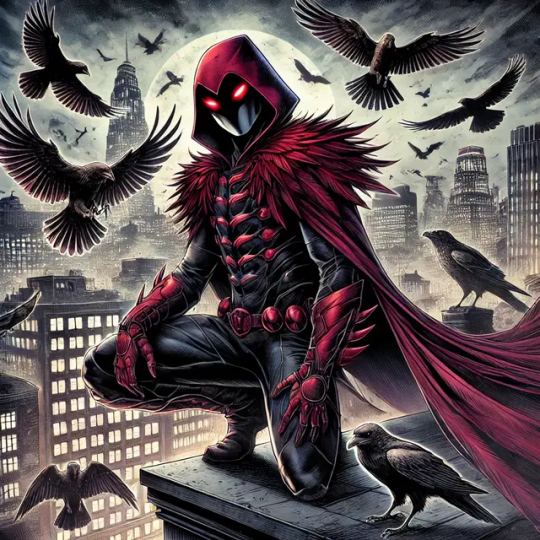
To deepen the storyline featuring MiracleMolly, Bambi, TheeDarkKnight, Domino, Punchline, and new villains/heroes like Nightshade, Red Raven, and Aetherium, I'll incorporate your new visual references and connect character motivations and alliances in a darker Gotham tale centered around the Heartstone artifact.
Act I: The Awakening of the Heartstone
Gotham City has always held secrets beneath its cobblestone streets and towering skyscrapers, but none as potent as the Heartstone. Hidden beneath the city, this ancient artifact pulses with energy that both heroes and villains sense as it begins to awaken. The Heartstone is said to be a relic of unparalleled power, capable of influencing minds, amplifying emotions, and warping reality itself.
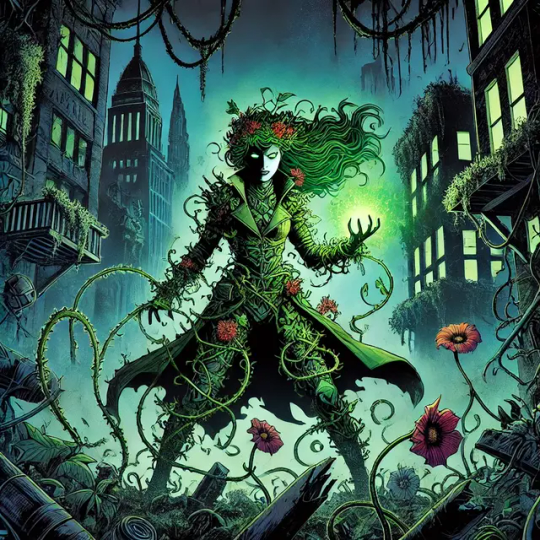
Nightshade, the eco-terrorist with control over toxic plants, senses the Heartstone as a dark blight poisoning Gotham’s natural world. She begins her assault on the city, creating deadly plant-infested zones and spreading a message of purging humanity from Gotham to reclaim the land. To her, the Heartstone represents humanity’s sins—its very existence a source of rot within the earth. She vows to possess it, intending to use its powers to return Gotham to nature, no matter the human cost.
In the shadows of the city, Red Raven watches from above, his red-feathered armor blending with the night sky. With his ability to control birds of prey and move seamlessly across Gotham's rooftops, he has earned a reputation as an enigmatic vigilante. Unlike Nightshade, Red Raven sees the Heartstone not as a curse but as a symbol of Gotham’s sins—a way to atone for its past. He wants the Heartstone to protect the future of Gotham and, if necessary, he is willing to make deals with the lesser of evils to secure it. Yet his motives are a mystery, and his alliances seem to shift depending on his own interpretation of justice.
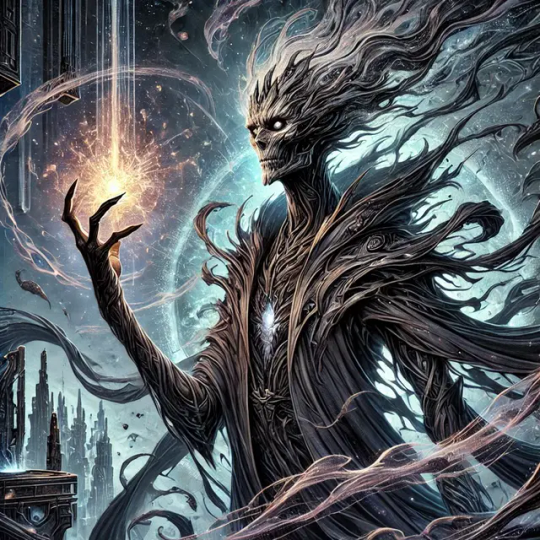
Meanwhile, Aetherium, a shadowy dimensional walker, arrives in Gotham. Drawn to the Heartstone like a moth to a flame, he views it as a key to new realms and sees in it a way to traverse dimensions unfathomable to mere mortals. Aetherium's allegiance is as fluid as his ability to step between dimensions. For him, the Heartstone is not a tool for justice or destruction, but a means to unlock limitless knowledge and power. He is willing to work with heroes or villains if it leads him closer to his prize.
Act II: Convergence of Forces
MiracleMolly, a reformed thief and tech expert, senses the unrest spreading through Gotham. Knowing the Heartstone’s potential for chaos, she contacts Bambi, who has recently returned to the city and taken on a role as a guardian for Gotham’s marginalized. Bambi, understanding the cultural weight and history behind artifacts like the Heartstone, agrees to help MiracleMolly. Together, they seek allies who will defend the artifact without exploiting it.
TheeDarkKnight (Rebecca Black), a dark and relentless vigilante who mirrors Batman’s ideals but with her own ruthless methodology, joins their cause. With her knack for blending into the shadows and striking fear, she brings an edge to their alliance that’s equal parts terrifying and reassuring. Despite her cold exterior, she shares a respect for Gotham’s past and understands the necessity of protecting the Heartstone from those who would abuse its power.
Domino, Harley Quinn’s unpredictable ally, and Punchline, the twisted new partner of Joker, arrive in Gotham under the guise of “helping” to secure the Heartstone. Domino’s luck-based powers and Punchline’s sinister charisma make them formidable opponents, especially when they realize the power contained within the Heartstone. Their loyalty, however, remains in question, as they see opportunities for personal gain.
Aetherium approaches Nightshade, offering his knowledge of the Heartstone in exchange for her cooperation. He manipulates her passion for cleansing the city’s impurities, suggesting that his dimensional abilities could help her spread her plant-based toxins beyond Gotham, to cleanse other cities and create a “paradise.” Nightshade agrees, forming a loose alliance with Aetherium, with the goal of eliminating all life in Gotham that she deems unworthy.
Act III: The Heartstone Hunt Begins
With alliances forged and motivations set, the hunt for the Heartstone begins. Each character’s path weaves through Gotham’s streets, converging in the city’s darkest alleys and abandoned buildings.
A Battle of Shadows: Red Raven and TheeDarkKnight confront Nightshade in the Botanical Gardens, which has been transformed into a twisted sanctuary of poisonous vines and sentient plant life. Red Raven’s control over birds clashes with Nightshade’s lethal plants, while TheeDarkKnight provides support from the shadows, using her gadgets to shield against toxic spores. They are almost overwhelmed, but Red Raven's precise strikes weaken Nightshade, forcing her to retreat.
Technology Meets Sorcery: MiracleMolly and Bambi, armed with technology and ancient lore, manage to decipher part of the Heartstone’s mysteries. They create a temporary shield to protect against the Heartstone's seductive energy, making it safer to transport. However, their efforts are interrupted by Domino and Punchline, who attempt to sabotage them, seeing their cooperation as a threat. The clash is both physical and psychological, as Punchline taunts MiracleMolly about her past crimes, weakening her resolve. But Bambi’s words about redemption empower MiracleMolly, allowing them to escape with the artifact.
Dimension Walkers: Aetherium’s true nature becomes evident as he confronts Red Raven, who has gained access to the Heartstone. Realizing that Red Raven wants to secure the Heartstone for Gotham’s future, Aetherium manipulates him by promising access to a realm where Gotham’s troubles never existed. Red Raven is momentarily swayed, his loyalty tested as he contemplates what Gotham could be without its history of pain.
Act IV: The Final Confrontation
The major factions gather for a climactic battle at Gotham’s central plaza, where the Heartstone’s energy begins to reach a breaking point. Nightshade arrives with her toxin-filled plants, intending to unleash a final attack on the city. Aetherium watches from the shadows, waiting for the opportune moment to seize the Heartstone and slip into another dimension.
Red Raven and Bambi confront Nightshade, determined to stop her before she wipes out Gotham’s population. MiracleMolly and TheeDarkKnight work to defuse the Heartstone, attempting to use a device to channel its power safely out of Gotham. Domino and Punchline, caught in the chaos, switch sides, realizing that the destruction of Gotham will prevent them from ever achieving the chaos and mischief they crave.
In a final act of desperation, Aetherium reveals his true plan: he intends to use the Heartstone to collapse all dimensions into one, creating a new reality under his control. Red Raven, seeing through Aetherium's deception, turns on him, his loyalty to Gotham finally solidified. The heroes and antiheroes rally together in an uneasy truce, each putting aside personal vendettas to prevent Aetherium's apocalyptic vision.
Act V: Redemption and Sacrifice
As the Heartstone reaches critical mass, Bambi realizes that only a pure heart can contain its energy without corruption. With a heavy heart, they volunteer, channeling the artifact’s power into themselves, effectively neutralizing it but at a great personal cost. The energy transforms Bambi, connecting them with Gotham itself, becoming a guardian spirit bound to the city’s history and future.
The Heartstone, now dormant, is buried deep beneath Gotham, watched over by MiracleMolly and TheeDarkKnight, who vow to protect it from future threats. Nightshade, defeated and realizing her vision for Gotham is unattainable, retreats into the wilderness, vowing to return when humanity least expects it. Aetherium, left without the Heartstone’s power, fades into the shadows, swearing vengeance on those who thwarted his plan.
The Heartstone saga ends with Gotham safe, but its defenders are forever changed. Each character’s journey through betrayal, redemption, and sacrifice highlights the fragile alliances that protect the city, even as new threats loom on the horizon.
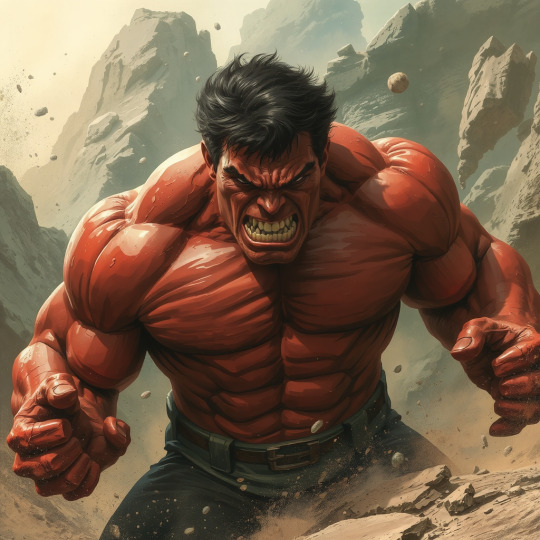
To start constructing the concept for #RedHulk: SMASH on PlayStation 7, here’s a preliminary breakdown for the gameplay, story, mechanics, and visual elements that could bring the Red Hulk experience to life:
Story Concept:
In #RedHulk: SMASH, players assume the role of Thunderbolt Ross as Red Hulk, navigating a world teetering on the edge of chaos. The game is set in a post-apocalyptic landscape where traditional heroes have been either eliminated or are in hiding. A dangerous faction of anti-superhero extremists, armed with advanced tech, have taken control of major cities. Red Hulk, with his raw power and relentless nature, stands as one of the last lines of defense against a complete power shift that could spell the end for mutants, heroes, and enhanced beings.
The narrative follows Red Hulk as he grapples with inner demons and rage, facing moral dilemmas about being both hero and monster. Alongside missions of intense combat and environmental destruction, Red Hulk encounters characters who question his motives, including other Hulk variants, survivors from previous Avengers rosters, and unexpected allies who see his raw power as their only chance.
Gameplay Mechanics:
Smash and Destruction-Based Combat:
Rage Meter: As Red Hulk takes or deals damage, his Rage Meter fills up, unlocking increasingly devastating moves. The higher the Rage Meter, the less control Red Hulk has, introducing a risk of uncontrollable outbursts.
Environmental Destruction: Players can destroy nearly every part of the environment. Buildings, vehicles, and urban landscapes are fully interactive, allowing Red Hulk to use debris and environmental objects as weapons.
Combat Combos and Finisher Moves: A range of brutal combos that evolve as players unlock new abilities or upgrades.
Traversal and Exploration:
Hulk Jumps and Wall Climbing: Red Hulk can leap great distances, climb up skyscrapers, and scale walls.
Smash Down Move: Allows Red Hulk to leap into the sky and come crashing down with a seismic wave, creating large shockwaves.
Super Speed: Incorporates Red Hulk’s swift movement to evade or charge into combat.
Character Customization and Upgrades:
Skill Tree: Players can upgrade Red Hulk’s strength, durability, Rage resistance, and combat techniques.
Appearance Mods: Unlock various cosmetic upgrades, like different Red Hulk outfits inspired by the comics, or experimental armors built to contain his power.
Weapons and Gadgets: Red Hulk occasionally utilizes military gear, allowing for ranged attacks or more tactical gameplay.
Allies and Enemies:
Cameos from Marvel Characters: Heroes like She-Hulk or villains like Abomination could show up as either allies, bosses, or opponents.
Unique Enemy Classes: From advanced tech soldiers with specialized gear to mutant-hunters designed to contain super-powered beings, enemies will challenge Red Hulk’s resilience and require different strategies.
Game Modes:
Story Mode: A full campaign that explores Red Hulk’s role in this dystopian world.
Arena Mode: Players can enter gladiator-style arenas and face off against waves of enemies to test Red Hulk’s limits.
Destruction Challenges: Time-limited challenges focused on causing maximum destruction within urban settings.
Interactive Environment and Dynamic Weather System:
Weather and Terrain Impact: From thunderstorms to earthquakes, the weather and terrain affect Red Hulk’s abilities and combat approach.
Day/Night Cycle: The game shifts from day to night, creating different atmospheres and enemy types that appear based on the time of day.
Visual and Audio Design:
Visual Aesthetic: Dark, gritty, with high-detail textures that make Red Hulk’s skin and muscle fibers look incredibly lifelike. Emphasis on destruction physics to make every smash satisfying.
Soundtrack: A mix of heavy, powerful orchestral tones with metal and electronic elements to match the intensity of Red Hulk’s nature.
Voice Acting: Red Hulk's voice should be gruff and filled with anger, contrasting with moments of somber introspection.
Potential Boss Battles:
Iron Patriot Faction Leader: A military-driven character with an anti-hero philosophy, using advanced Iron Man-like armor.
Mutant Sentinel: A massive robot created to hunt down super-powered individuals, using Red Hulk’s own abilities against him.
Doctor Doom (or equivalent): A strategic and power-hungry villain who manipulates Red Hulk into doing his bidding, ultimately becoming a formidable opponent.
This structure would give #RedHulk: SMASH an intense and gritty feel, placing players in the role of a raw, unrestrained powerhouse navigating moral gray areas while protecting a world that fears and rejects him. Let me know if you'd like to expand on any of these aspects, develop specific story arcs, or brainstorm further gameplay scenarios!
#RedHulk#enXantingNOIR#theedarkknight#Batman#DCcomics#DCcomics x Marvel#jorge jimenez#playstation7#deardearestbrands#ps7#digitalconsole#python#framework
5 notes
·
View notes
Text
Passiflora secrets: what do you know really?

Here we are with this new format. I promised you I would have proposed it. We will talk about in the next episode of Passiflora
I ask you to answer sincerely to the questions. It's not a problem if you don't know the answers.
This is a simple survey. Ready?
1. How familiar are you with Passiflora (Passion Flower)?
Very familiar
Somewhat familiar
Not familiar at all
2. Have you ever used Passiflora for any purpose? (e.g., medicinal, culinary, ornamental)
Yes
No
3. If yes, please specify how you have used Passiflora:
Medicinal purposes
Cooking or baking
Landscaping or gardening
Other (please specify)
4. What benefits do you associate with Passiflora?
Stress relief
Improved sleep
Enhanced digestion
Other (please specify)
5. Are you aware of any side effects or precautions related to Passiflora use?
Yes
No
6. Would you be interested in learning more about Passiflora and its applications?
Yes
No
7. Any additional comments or experiences you'd like to share about Passiflora?
Thank you for taking the time to complete this survey! Your feedback is invaluable.
The next article will be come soon!
Source: Passiflora secrets: what do you know really?
0 notes
Text
Jups.io Slot Games: Exciting Gameplay and Trusted Transactions
In the dynamic world of online gaming, Jups.io stands out as a premier crypto casino, offering an exhilarating selection of slot games that captivate players worldwide. As a leading no KYC crypto casino, Jups.io combines thrilling gameplay with seamless investment and withdrawal processes, ensuring a trustworthy and user-friendly experience. This article delves into the allure of Jups.io’s slot games, highlights the platform’s reliability, and underscores why it’s a top choice for crypto casino enthusiasts. Visit Jups.io to explore this exciting gaming hub.
Slot Games: A World of Spins and Wins
Slot games are the heartbeat of any crypto casino, and Jups.io delivers an impressive array of options to suit every player’s taste. These games feature vibrant graphics, engaging themes, and rewarding mechanics, making them a favorite among casual and seasoned gamblers alike. Popular titles include classic three-reel slots, modern video slots with immersive storylines, and progressive jackpot slots offering life-changing payouts. Each slot game operates on a Random Number Generator (RNG), ensuring fair and unpredictable outcomes, a hallmark of Jups.io’s commitment to transparency in its no KYC crypto casino environment.
Playing slots on Jups.io is straightforward yet thrilling. Players select their bet size, spin the reels, and aim to align symbols across paylines to win. Bonus features like free spins, wild symbols, and multipliers enhance the excitement, increasing the potential for big wins. Whether you’re chasing a jackpot or enjoying a quick spin, Jups.io’s slot games deliver endless entertainment. The platform’s intuitive interface ensures easy navigation, allowing players to dive into the action without delay, a key advantage of this crypto casino.
Why Jups.io is a Trusted Crypto Casino
Jups.io’s reputation as a reliable no KYC crypto casino stems from its commitment to player satisfaction and operational excellence. Unlike traditional online casinos, Jups.io eliminates the need for lengthy Know Your Customer (KYC) verification, allowing players to register and play with just an email address. This privacy-focused approach appeals to crypto enthusiasts who value anonymity, making Jups.io a standout in the crypto casino space. The platform’s use of blockchain technology ensures secure transactions, protecting players’ funds and data.
Jups.io’s reliability is further evidenced by its robust game offerings and partnerships with top-tier software providers. These collaborations guarantee high-quality, provably fair games, reinforcing trust among players. The no KYC crypto casino model also aligns with the ethos of decentralization, offering a seamless gaming experience without bureaucratic hurdles. Players can focus on enjoying their favorite slots, confident in the platform’s integrity.
Seamless Investment and Withdrawal Processes
One of Jups.io’s strongest attributes is its flawless investment and withdrawal system, a critical factor for any crypto casino. The platform supports a wide range of cryptocurrencies, including Bitcoin, Ethereum, and Tether, enabling instant deposits with no fees. Players can fund their accounts in seconds, ensuring uninterrupted gameplay. This efficiency is a testament to Jups.io’s status as a leading no KYC crypto casino, prioritizing speed and convenience.
Withdrawals are equally seamless, with Jups.io processing payouts rapidly, often within minutes. Unlike some platforms that impose delays or hidden fees, Jups.io ensures players receive their winnings promptly, reinforcing its reliability. The absence of KYC requirements streamlines the withdrawal process, allowing players to access funds without submitting personal documents. This player-centric approach makes Jups.io a trusted choice for crypto casino enthusiasts seeking hassle-free transactions.
Conclusion: Spin with Confidence at Jups.io
Jups.io’s slot games offer a thrilling blend of entertainment and opportunity, making it a go-to destination for crypto casino fans. As a no KYC crypto casino, it prioritizes privacy, security, and ease of use, delivering a gaming experience that’s both exciting and trustworthy. With seamless investment and withdrawal processes, Jups.io ensures players can focus on the fun without worrying about delays or complications. Whether you’re a slot enthusiast or new to crypto gaming, Jups.io provides a reliable and rewarding platform to spin and win. Join today at Jups.io and discover the future of online gaming.
2 notes
·
View notes
Text
Fun thing that happened today: because I hoard old software, I’ve accidentally made my future easier.
For a few months now I’ve been planning on doing some serious DOS programming, but there’s a catch with this: creating sound effects isn’t like it is under modern operating systems. I’ll have to modulate the speakers with my own code.
Now that’s doable enough, but I’ll need to make some custom tools, and to do that, I’ll have to figure out the sound system, graphics system, and input system in one big go. That doesn’t sound like a good idea just yet.
But, I set up a Windows 98se virtual machine so that I could have a graphical development environment, and everything seemed ready to go.
Then this morning I had a brilliantly stupid idea: I still have the old IDE I used twenty years ago. Got it out, installed it, and now I’ve almost finished the tool I need to work with sounds in DOS. The tool uses the Windows API for everything except playback, so I’m working in familiar territory.
3 notes
·
View notes
Text
Redefining Traditional Office Culture: How Coworking Spaces in Pune are Leading the Change
In the vibrant city of Pune, where innovation meets tradition, a quiet revolution is underway, reshaping the way people work and interact. At the heart of this transformation are coworking spaces, bustling hubs of creativity and collaboration that are redefining the very fabric of traditional office culture.
Gone are the days of mundane cubicles and rigid hierarchies; today, professionals in Pune are flocking to coworking spaces in search of something different. These dynamic environments offer more than just a place to work — they provide a community, a support system, and a platform for growth.
One of the most striking ways in which coworking spaces are reshaping office culture is by fostering a sense of community and collaboration. Unlike traditional offices where employees often work in silos, coworking spaces encourage interaction and networking among members from diverse backgrounds and industries. In coworking space in Pune, you’re just as likely to strike up a conversation with a tech entrepreneur as you are with a freelance graphic designer, leading to serendipitous encounters and valuable connections.
Moreover, coworking space in Pune are breaking down barriers and fostering a culture of openness and inclusivity. Whether you’re a solopreneur, a small startup, or a remote worker, there’s a place for you in the coworking community. This diversity not only enriches the collaborative experience but also promotes tolerance and understanding among members.
But perhaps the most significant way in which coworking spaces are redefining traditional office culture is by embracing flexibility and adaptability. In a world where change is the only constant, traditional offices can feel stifling and outdated. Coworking spaces, on the other hand, offer a flexible and agile environment where members can scale their operations up or down as needed, without being tied down by long-term leases or fixed overheads.
In Pune, where the startup scene is booming and innovation is prized above all else, coworking spaces have become the natural habitat for entrepreneurs and creatives alike. These spaces provide the infrastructure and support needed to turn ideas into reality, offering everything from high-speed internet and state-of-the-art facilities to mentorship and networking opportunities.
In conclusion, Co Working space in Pune are not just places to work; they’re catalysts for change, driving innovation, collaboration, and community-building in a city that thrives on diversity and dynamism. By redefining traditional office culture and embracing flexibility, inclusivity, and collaboration, coworking spaces are shaping the future of work in Pune and beyond. Join the revolution today and discover a new way of working that’s as inspiring as it is transformative.

7 notes
·
View notes
Note
what is your current obsession?
i want to make a paper mario/undertale style RPG that's themed around 3D graphics tech (think of how superstar saga's entire world is all related to beans and jokes)
locations like "shader valley", "the subsurface", "normalberg", "perlin desert", "the asset library", etc
items/weapons that are literal tools from blender/graphics software
comic relief rival gangs (ala paper mario) where one gang thinks that in an XYZ coordinate system, Z is up and the other gang thinks Y is up
fun in-world puzzles that have you do 3D editing operations to things in the environment to solve problems/overcome obstacles (like what if there's a very dark room and you gotta switch to wireframe mode to see where everything is)
29 notes
·
View notes
Text
Resolution Independence, Zoom, Fractional Scaling, Retina Displays, High-DPI: A Minefield
I already explained how CPU dispatch is a minefield: It doesn't cause intermittent bugs. It often doesn't even cause crashes. Badly implemented CPU dispatch means you build something on your machine that runs on your machine, but doesn't perform the dispatch correctly, so it crashes on somebody else's machine, or something build on a worse machine still runs fine on a better machine, but not as well as it could. Some of the bugs only manifest with a different combination of compiler, build system, ABI, and microarchitecture. CPU dispatch is a minefield because it's easy to get wrong in non-obvious ways.
I recently played an old game on Windows 11, with a high-DPI 2560x1600 (WQXGA) monitor. Text was too small to read comfortably read, and the manufacturer had set the zoom level to 150% by default. When I launched the game, it started in fullscreen mode, at 2560x1660, which Windows somehow managed to zoom up to 3840x2400. The window was centered, with all the UI elements hidden behind the edges of the screen. When I switched from fullscreen to windowed, the window still covered the whole desktop and the task bar. I quit the game and switched to another. That game let me choose the resolution before launch. At first I tried 2560x1660, but nothing worked right. Then I started it again, at 1920x1080. It didn't look quite right, and I couldn't understand what was going on. Windows has scaled the game up to 2880x1620, which looked almost correct. At this point I realised what was happening, and I set the zoom to 100%. Both games displayed normally.
The first game was an old pixel art platformer from the early 2000s, with software rendering. The second is a strategy game built with OpenGL around 2015, with high-resolution textures based on vector art, and with a UI that works equally well on an iPad and on a PC.
It was hard to read things on that monitor, so I set the font scaling to 150%, but somehow that made things harder to read. Some applications did not honour the font size defaults, and others did, and still others had tiny UI elements with big letters that were spilling out.
Next, I tried to run a game on Ubuntu, with Sway (based on wayland) as the desktop environment. It's a different machine, a 15.6 inch 1920x1080 laptop with an external 1920x1080 23 inch monitor attached. I zoomed the internal display of the laptop by 150% in order to have windows appear equally sized on both monitors.
What is happening on Windows 11 seems to be that even OpenGL games that don't think in terms of pixels, but in terms of floating point coordinates that go from -1 to +1 in both the x and y dimension, (so 0.1 screen units are different sizes in different dimensions) are treated the same as software rendering games that give a buffer of software-rendered pixels to the operating system/graphics environment. Making an already resolution-independent window bigger feels pointless.
What I would want to happen by default, especially in the case of the software-rendered game, is for the operating system to just tell my game that the desktop is not sized 2560x1600, but 1706x1066 (or just 1600x1000), and to then scale that window up. If the window is scaled up, mouse position coordinates should be automatically scaled down from real pixels to software pixels, unless the mouse cursor is captured: If I am playing a DOOM clone or any first-person game, I do not want relative mouse sensitivity to decrease when I am playing on a 4K monitor or when I am maximising the window (if playing in windowed mode). If I have a retina/zoomed display attached, and a standard definition/unzoomed display, and there is a window overlapping both screens, then only the part of a window that is on the zoomed display should be zoomed in.
What I would want to happen with a "resolution-independent" game is this: The game queries the size of the monitor with a special resolution-independent query function. There is no way to "just make it backward compatible". This is a new thing and needs new API. The query returns
Size of all desktops in hardware pixels
Size of all screens in real-world centimetres
Preferred standard text size in pt/cm (real world) or pixels
Zoom factor (in percent) of all desktops
Which screens are touch or multi-touch screens
Is dark mode enabled?
Which desktop is "currently active"
The "preferred" desktop to open the window
This information would allow an application to create a window that is the appropriate size, and scale all text and UI elements to the appropriate size. We can't assume that a certain size in pixels is big enough for the user to comfortably hit a button.
Even this information might not be enough. What should be the behaviour if a windowed OpenGL application is dragged between a 4K monitor at 200% zoom, and a 640x480 CRT? Should the OS scale the window down the same way it currently scales windows up when they aren't "retina aware"?
I don't really know. All I do know is that Windows, Mac OS, and different wayland compositors all handle high-DPI zoom/retina differently, in a way that breaks sometimes, in some environments. But it looks fine if you don't have scaling set. There are ways to tell the windowing system "I know what I am doing" if you want to disable scaling, but these are easy to abuse. There's a cargo cult of just setting "NSHighResolutionCapable" or "HIGHDPIAWARE" without understanding why and why not. Win32 provides all the information you need, with a very complex API. Wayland has a very different approach. SDL is aware of the issue.
I really hope SDL3 will make this work. If you get this wrong, you'll only realise when somebody on a different operating system with a different monitor tries to get your game to fit on the screen by fiddling with the registry, and it goes from not fitting on the monitor to text being too small read.
8 notes
·
View notes